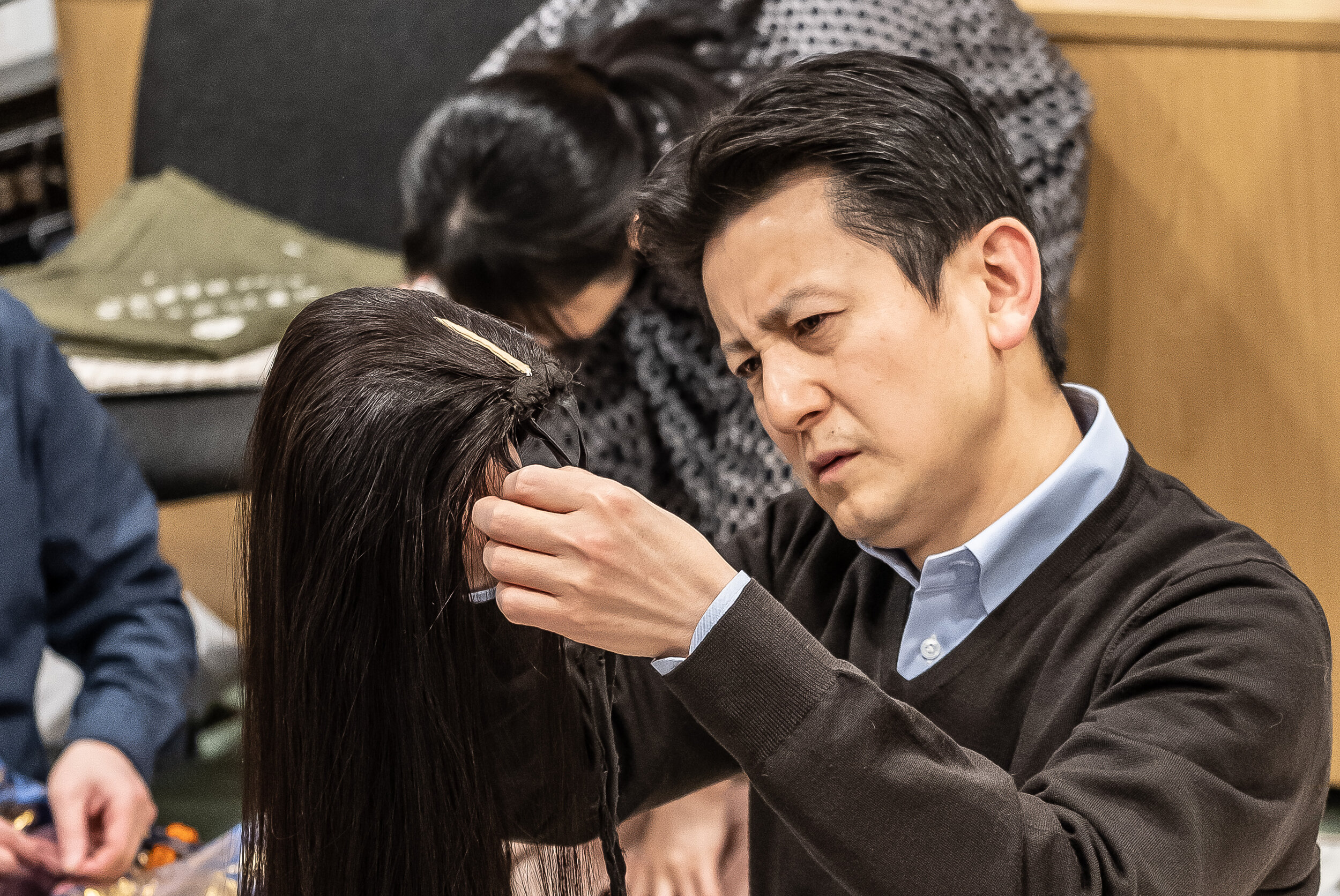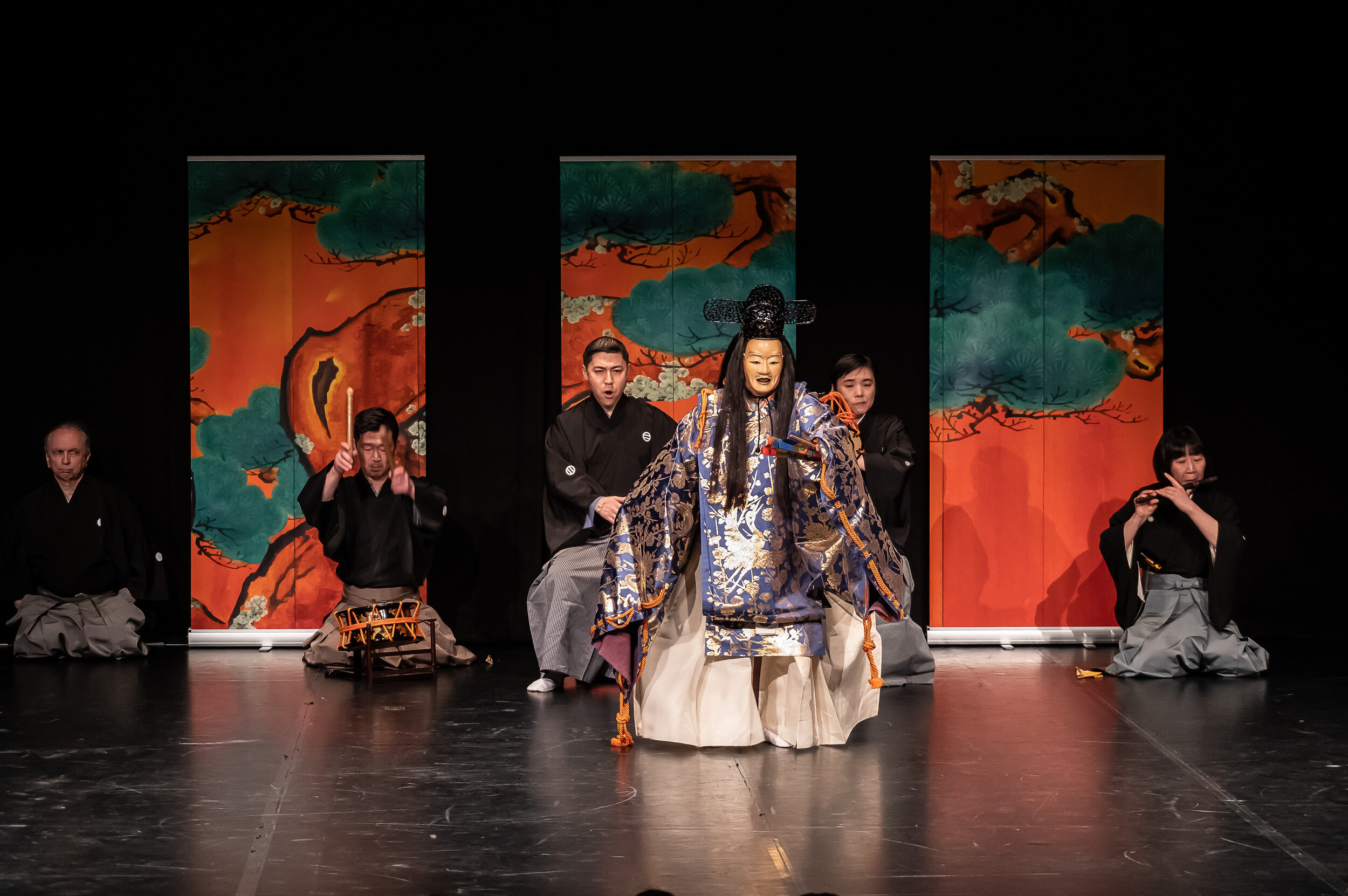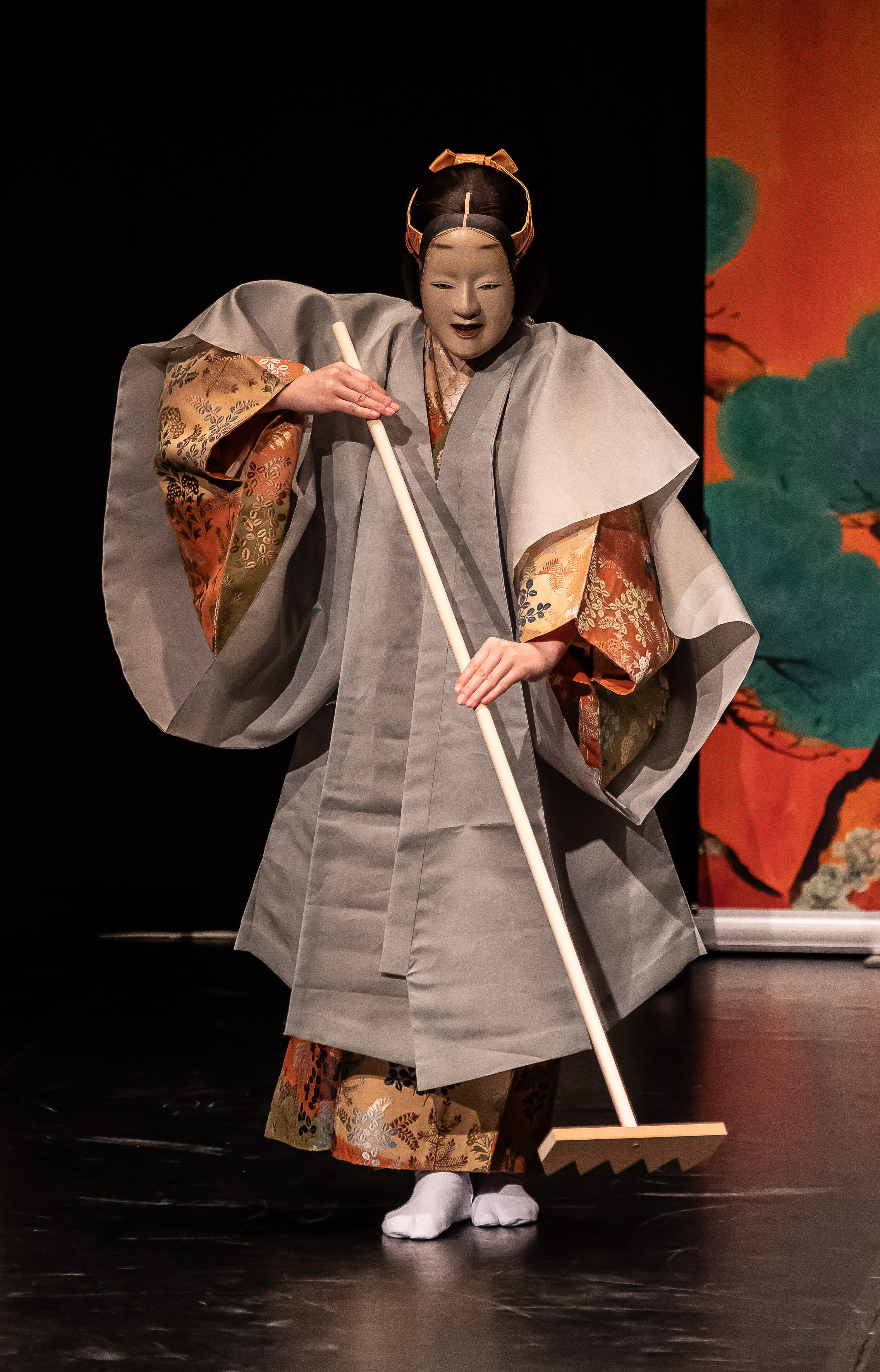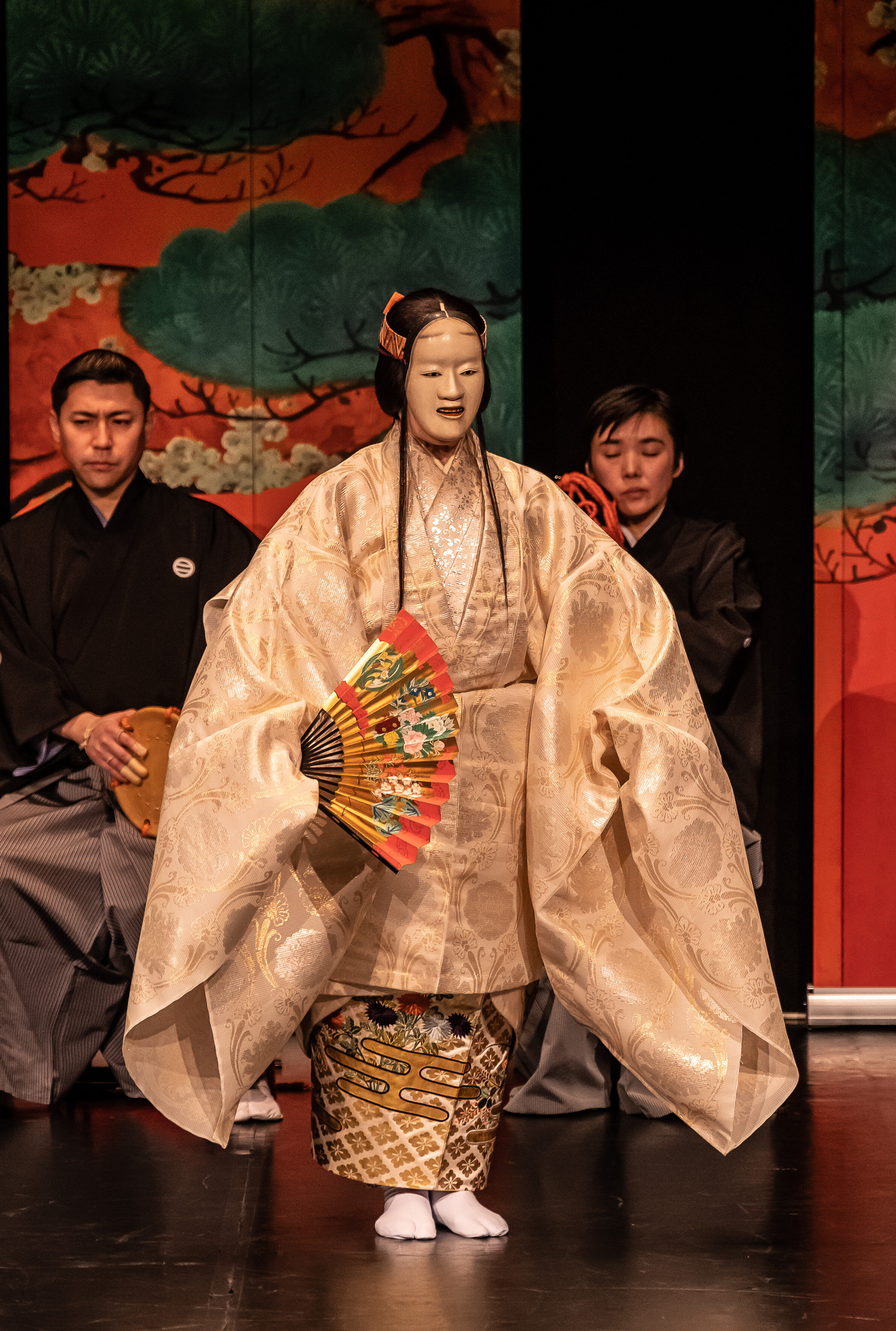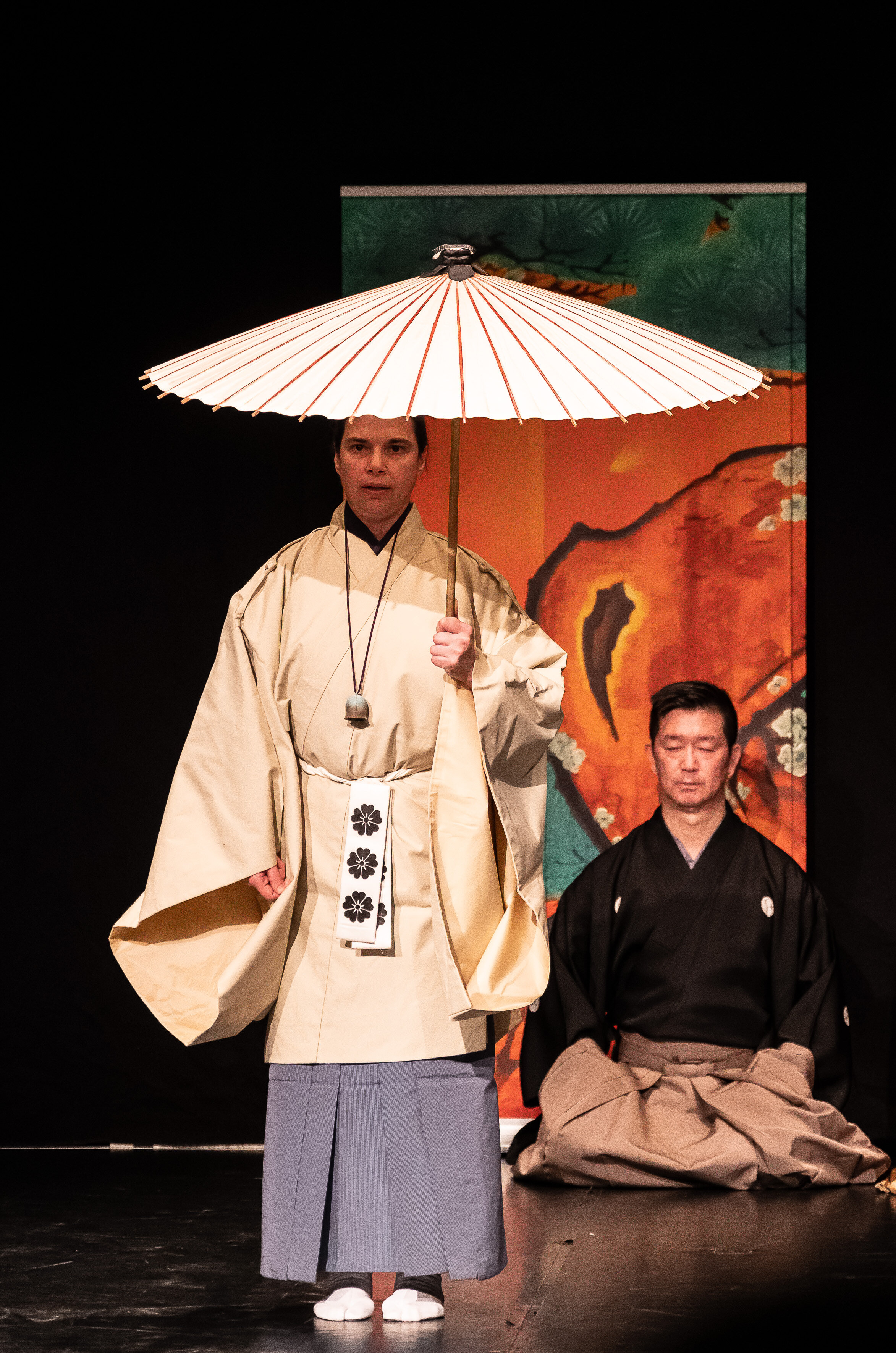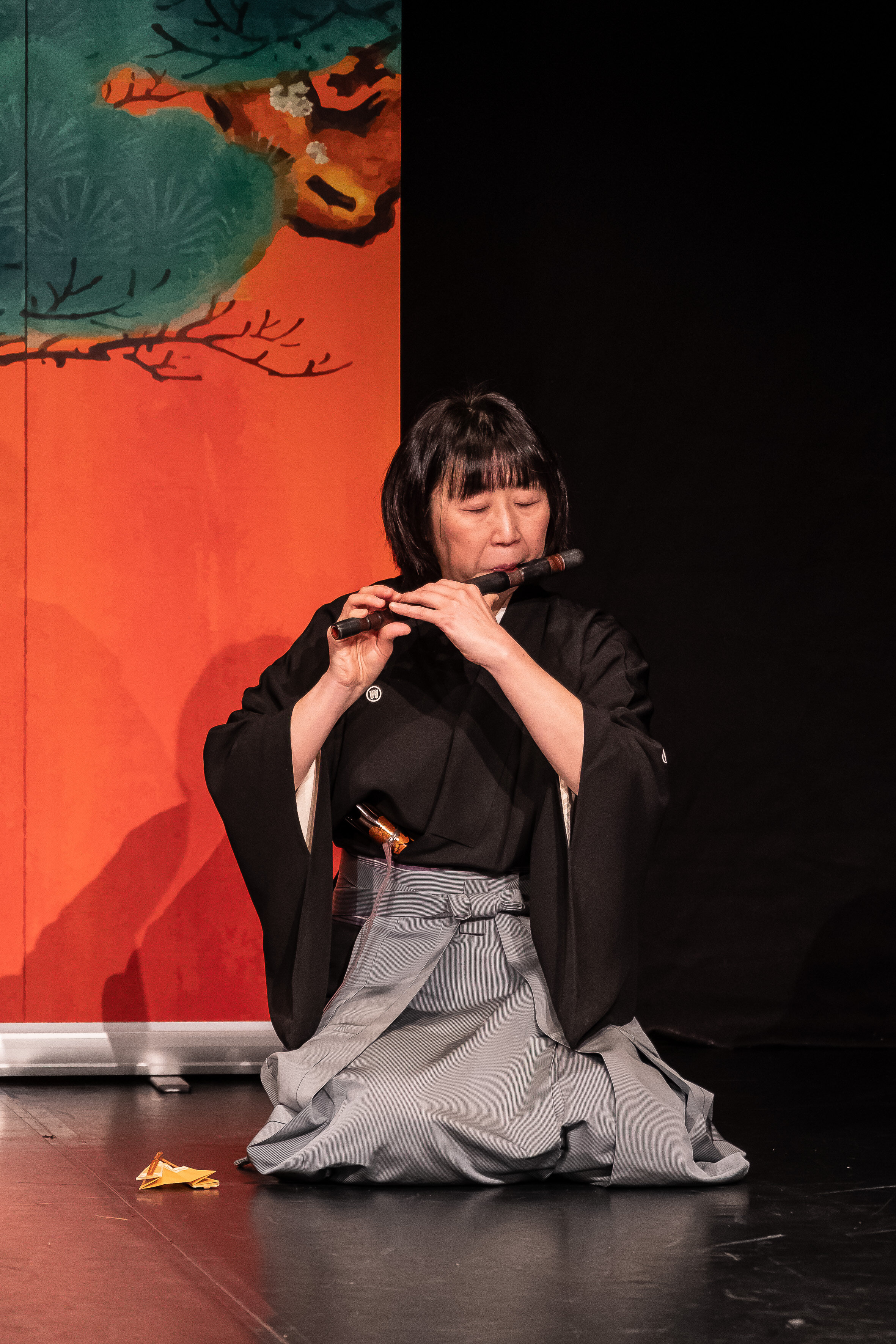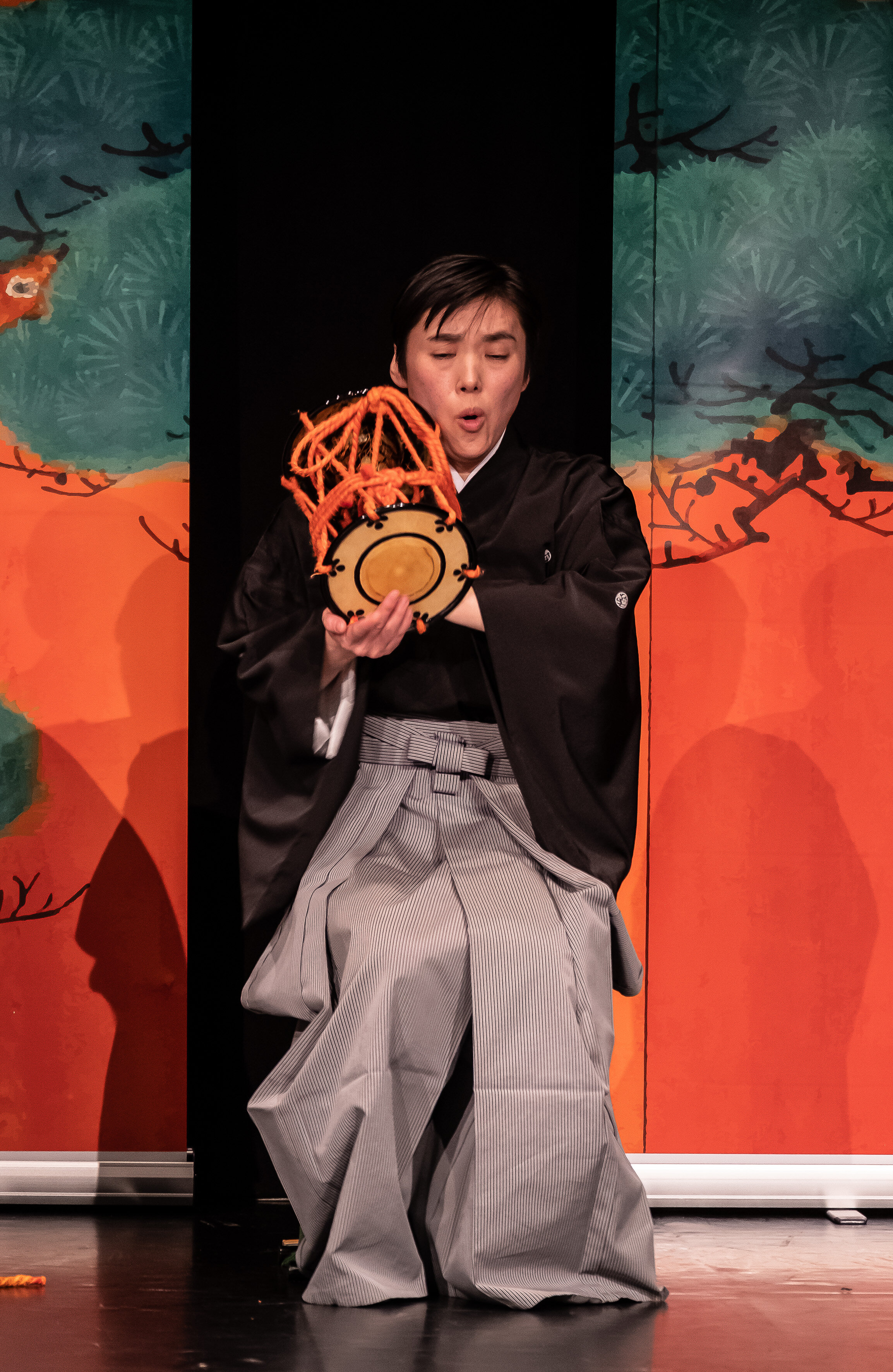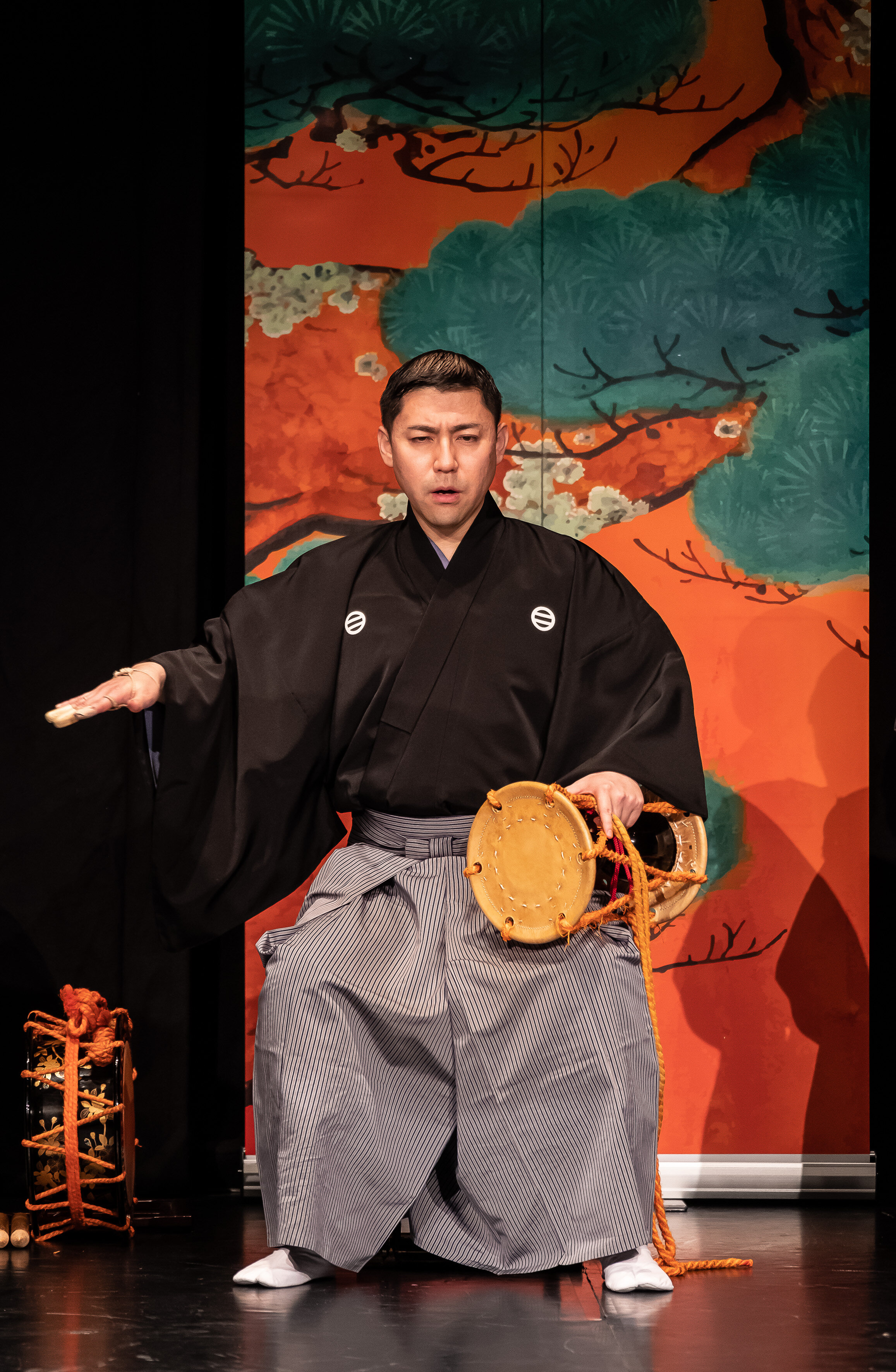“I wanted to send my heartiest congratulations to you all for the amazing events you organised. The performances at the BL were very well received and the production at the Southbank was a real triumph. I found that the BL Highlights event was a perfect preparation for the full performance and gave a real insight both into the characteristics and history of Noh and into the creative process. Those who followed all three phases of ‘Getting to Noh’ really did get the chance to go on a journey from ‘page to stage’. Please send our collective thanks and appreciation to all those involved. We look forward to your next project….!
”
Above: Between the Stones film recording. Musée Guimet, the National Museum of Asian Arts, Paris. (February 2020)
Between the Stones
Objectives
Contribute to the development of new audiences for traditional and contemporary noh
Foster a better understanding of the key elements of noh internationally (as well as in Japan) from ‘page to stage’
Improve international cultural relations and development through cross-cultural artistic engagement
Highlight the creative connections between noh, and other forms of art, culture and society
Give focus to noh as not only a continuously performed theatre art but also one that is continuously developing and expanding its reach.
Background
The Between the Stones Project included the development of the new English language noh drama (Between the Stones) by Jannette Cheong (author) and Richard Emmert (composer) which toured to the UK, Ireland and France just before the first UK pandemic ‘lock-down’ in 2020, plus an extensive programme of education and outreach activities - 'Getting to Noh' to provide an up-close understanding of noh before, during and after the 2020 tour.
This project was an official event of the Japan-UK Season of Culture (2019-2021). It was co-produced by Jannette Cheong, Richard Emmert, Paul Laikin in association with the Oshima Noh Theatre, Theatre Nohgaku and Unanico and was in three phases:
Phase 1 (2018-19)
Illustrated talks, plus initial readings of the new noh, covering public events, education and outreach activities, including work with the Coventry Young Ambassadors through all phases to 2021.
Phase 2 (2019)
Development workshop for the new noh in London with members of the Oshima family, the composer and the author
Second reading at the Japanese Embassy in London with British actor Simon Callow
Getting to Noh education and outreach work at events in London, Coventry, Dublin and Paris.
Phase 3 (27 January - 6 February 2020)
The Performance Tour - Performances included a han noh (half noh), of the classical noh, Takasago, and the complete new noh - Between the Stones.
Plus, more education and outreach activities, especially our ‘Getting to Noh’ masks programme with our mask maker, Kitazawa Hideta.
Project activities were of interest to those engaged in, or fascinated by, Japanese arts and culture, and also built new relationships by sharing ideas and learning through cultural and educational engagement both inside and outside the world of noh.
The project continues to support other associated education activities following the interest of the UNESCO Associated Schools Programme Network (ASPnet) to extend the Cities of Peace Schools Projects beyond the initial five primary schools in Coventry through the establishment of the UNESCO ASPnet Arts & Culture for Peace Initiative.
The 2020 European Performance Tour Programme
Co-produced with Unanico, in association with Oshima Noh Theatre and Theatre Nohgaku.
The 2020 Takasago & Between the Stones tour involved 18 collaborating artists from Japan, the USA and the UK. This unique programme of classical and contemporary noh contributed to the 2020 Japan-UK Season of Culture.
28 January, London - British Library, Eliot Room: Unmasking Noh: The Art of Noh Mask-making with Hideta Kitazawa
29 January, London - Southbank Centre, Purcell Room: Takasago (Act 2) & Between the Stones (World Premiere Performance)
30 January, London - Japan House: The Art of Mask-making: Hideta Kitazawa
30 January, London - British Library, Knowledge Centre Theatre: Getting to noh: noh performance highlights
31 January, London - Southbank Centre, Purcell Room: Takasago (Act 2) & Between the Stones
31 January, Southend - Special all day workshop with East 15 Acting School, University of Essex: Getting to noh masks: Hideta Kitazawa (Student workshop)
1 February, Kilkenny, Ireland - Watergate Theatre: Getting to noh masks with Hideta Kitazawa
1 February, Kilkenny, Ireland - Watergate Theatre: Takasago (Act 2) & Between the Stones
2 February, Wexford, Ireland - National Opera House, Jerome Hynes Theatre: Getting to noh masks with Hideta Kitazawa.
2 February, Wexford, Ireland - National Opera House, Jerome Hynes Theatre: Takasago (Act 2) & Between the Stones
4 February, Paris - Musée Guimet, National Museum for Asian Arts: Getting to noh masks with Hideta Kitazawa
4 February, Paris - Scroll to the top to view the performance at the Musée Guimet, National Museum for Asian Arts: Takasago (Act 2) & Between the Stones.
6 February, Coventry - Special all day event for the Coventry Young Ambassadors - Getting to noh masks with Hideta Kitazawa, Kinue Oshima, Richard Emmert and Jannette Cheong, in association with the Japan Society and the Between the Stones Project.
Classical and contemporary noh
Performing both classical and contemporary noh in the same programme allowed the audience to gain some experience of similarities and differences between classical noh (sung in classical Japanese) and contemporary noh (sung in contemporary English) both using traditional noh techniques.
Takasago, written by Zeami Motokiyo (1363-1443?), is one of the most important and well-known plays in the classical noh repertoire.
The play deals with the legend of the twin pines of Sumiyoshi and Takasago personified in the first half by an aged couple. Sumiyoshi and Takasago are located across from each other on the Osaka Bay. According to legend, the spirit of the Sumiyoshi pine travels nightly to visit his wife, the Takasago pine, in a bond that defies age and time. The twin pines are also symbolic of the two great poetic anthologies, the Man’yôshû and the Kokin Wakashû (or Kokinshû), and by implication suggest the prosperity of the land due to the observance of the high moral and aesthetic principles exemplified in these two poetic anthologies.
Three priests from Aso Shrine in Kyûshû are on their way by boat to visit the capital and decide to stop off at Takasago to visit the famed Takasago Pine. There they meet an old couple sweeping the pine needles and ask them why the Takasago Pine is considered a twin pine of the Sumiyoshi Pine which is far away. The old couple tells the legend of the pines before they reveal that they in fact are the spirits of the two ancient pine trees. They invite the priests to visit the Sumiyoshi Shrine to see its pine as well. In the second half, the part performed today, the Priests visit the Sumiyoshi Shrine where the young vigorous god of the shrine appears to them and dances.
Between the Stones, written by Jannette Cheong with music by Richard Emmert, is an English noh in two acts.
It explores how one finds peace, beauty and love following tragic loss, and was written following the deaths of family members and a mentor and friend close to the author. It is a celebration of life, death and friendship and demonstrates the transformative power of gardens and gardening to nurture and heal the soul.
The lead role in the world premiere and European tour of the new contemporary English-language noh, Between the Stones was performed by Kinue Oshima. Kinue plays the role of the Woman Gardener in Act 1 and as the Spirit of the Silent Waves in Act 2. 11-year old, Iori Oshima, performs his international debut, as the child actor, nochi-kokata role as the Spirit of Winter Butterflies in Act 2. Iori is the latest generation of rising noh actors from the Oshima family.
Jubilith Moore plays the Waki (secondary actor) role as the Traveller, and Ashley Thorpe plays the priest in the interlude.
Background
The noh-related works written by Jannette Cheong reflect universal themes. For Between the Stones the concepts and themes explored are finding peace, beauty and love from tragic loss. Between the Stones was written following the deaths of family members and a mentor and friend close to the author. It is a celebration of life, death and friendship, demonstrating the transformative power of gardens and gardening to nurture and heal the soul. The piece draws on reflections about ‘limits’ and the following thoughts:
On grief
Tragic loss is likely to be felt, at some time, by everyone, but it can be hard to share intense grief. It is something deeply personal, inward facing and debilitating, especially when loved ones are lost. Reconciling the only fact that can be predicted about human beings – that they will die – with the process and consequences of death itself, is one of the greatest challenges for the living.
On friendship and mentors
Someone who becomes a lifelong friend and mentor takes trust and support to the highest level. They are not unearthly, nor are they faultless, but they have an ability to find you when you think you are lost, and they can join you on those sections of life’s journey when you most need a companion.
On gardening
The first time the rake was pulled across the gravel the author knew this was to be an intense physical activity and quite contrary to the engagement with the overall aesthetic of the finished fully raked garden. But she was to discover that this was one of the crucial points of engaging in such gardening – or any gardening for that matter.
Everyone may appreciate a garden by taking a stroll through it, or admiring its beauty, but gardeners do something else. Gardening is a total physical experience for mind and body, emotions and feelings, creative abilities and talents and also immensely pragmatic and of this earth. This applies to all gardens whether big or small; whether plant life is plentiful, or (as in karesansui gardens) almost non-existent.
Setting
Between the Stones is set in two karesansui gardens far apart.
Synopsis
In the middle of a typhoon, a traveller grieving lost loved ones visits the stone garden in Ryoanji Temple in Kyoto. The traveller meets a woman gardener who understands the traveller’s sadness and shows how the raking of its gravel enhances its beauty and evokes a peaceful soul. After the gardener disappears, a priest arrives to close the garden having heard of the typhoon’s destruction elsewhere including the loss of two children. When the traveller mentions the woman gardener the priest says that women gardeners do not rake the garden and suggests, after mentioning the garden’s other mysteries, that the traveller might have felt the spirit of the garden while meditating.
Several years later the traveller, now back in Europe, decides to build her own stone garden and is visited by the spirit of the garden—now the spirit of the silent waves, reflecting the waves of the garden when raked. They discuss the courage of those who face death and the spirit describes the final release before death “like winter butterflies in a silent breeze.” Then the spirit of winter butterflies appears and dances in memory of departed loved ones.
This noh draws on the ‘setting of the stones’ - the creation of gardens - and the solace and space they provide for reflection. The traveller realises that two gardens far apart share a legacy of enduring peace, beauty and love.
Akira Matsui performing Takasago
Photography by Clive Barda
Takasago was performed by Akira Matsui with Ryoichi Kano, Teruhisa Oshima, Shigenobu Uchida and John Oglevee as the Chorus and Richard Emmert as the koken (Stage assistant).
Koken (stage assistants) for Between the Stones were Akira Matsui, Ryoichi Kano, and for Takasago were Richard Emmert, Ryoichi Kano, Teruhisa Oshima and Shigenobu Uchida.
Photography by Clive Barda
11-year old, Iori Oshima, performing Spirit of the Winter Butterflies
Photography by Clive Barda
The chorus comprised: Richard Emmert, Teruhisa Oshima, Shigenobu Uchida, John Oglevee and Laura Sampson.
Hayashi instrumentalists were: Narumi Takizawa (nohkan) flute, Naoko Takahashi (kotsuzumi) shoulder drum, Eitaro Okura (otsuzumi) hip drum, Kiyoshi Yoshitani (taiko) stick drum.
The Woman Gardener noh mask created by Kitazawa Hideta. Photography by Sohta Kitazawa
Winter Butterflies released
Silent in the breeze
Silent in the ocean’s waves …
A poem from Between the Stones by Jannette Cheong, which is also on the tanzaku poem card that appears at the end of the play.
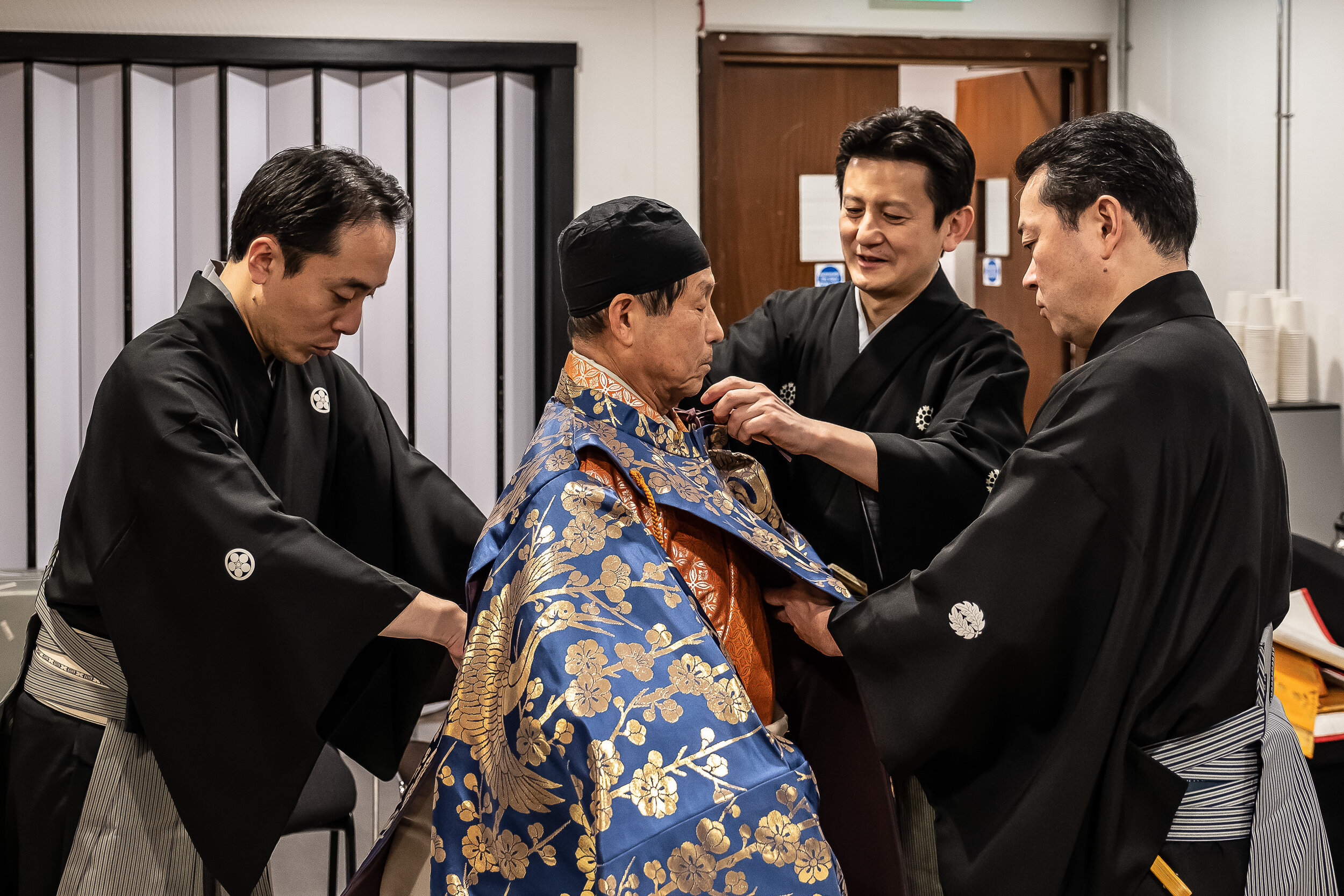
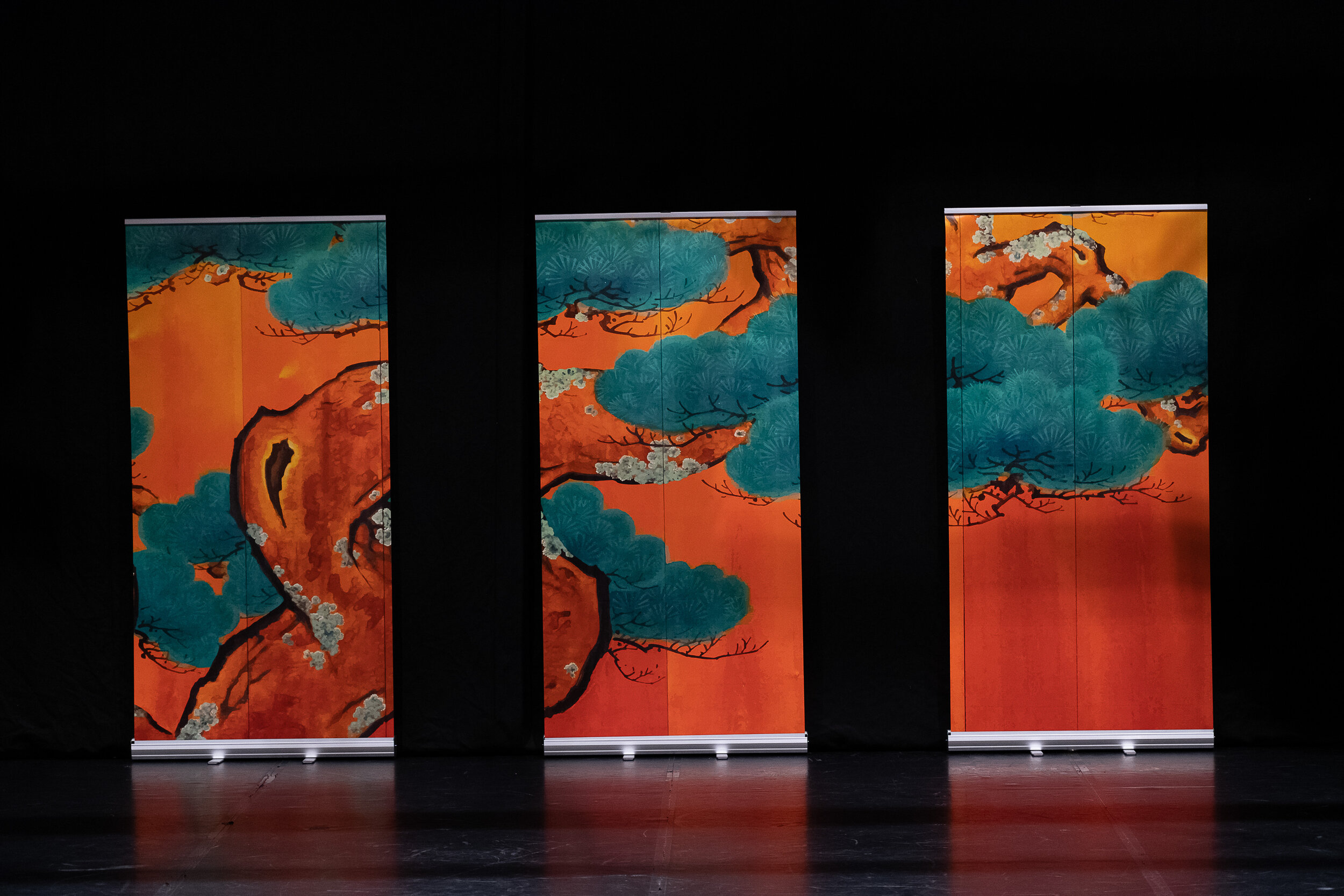
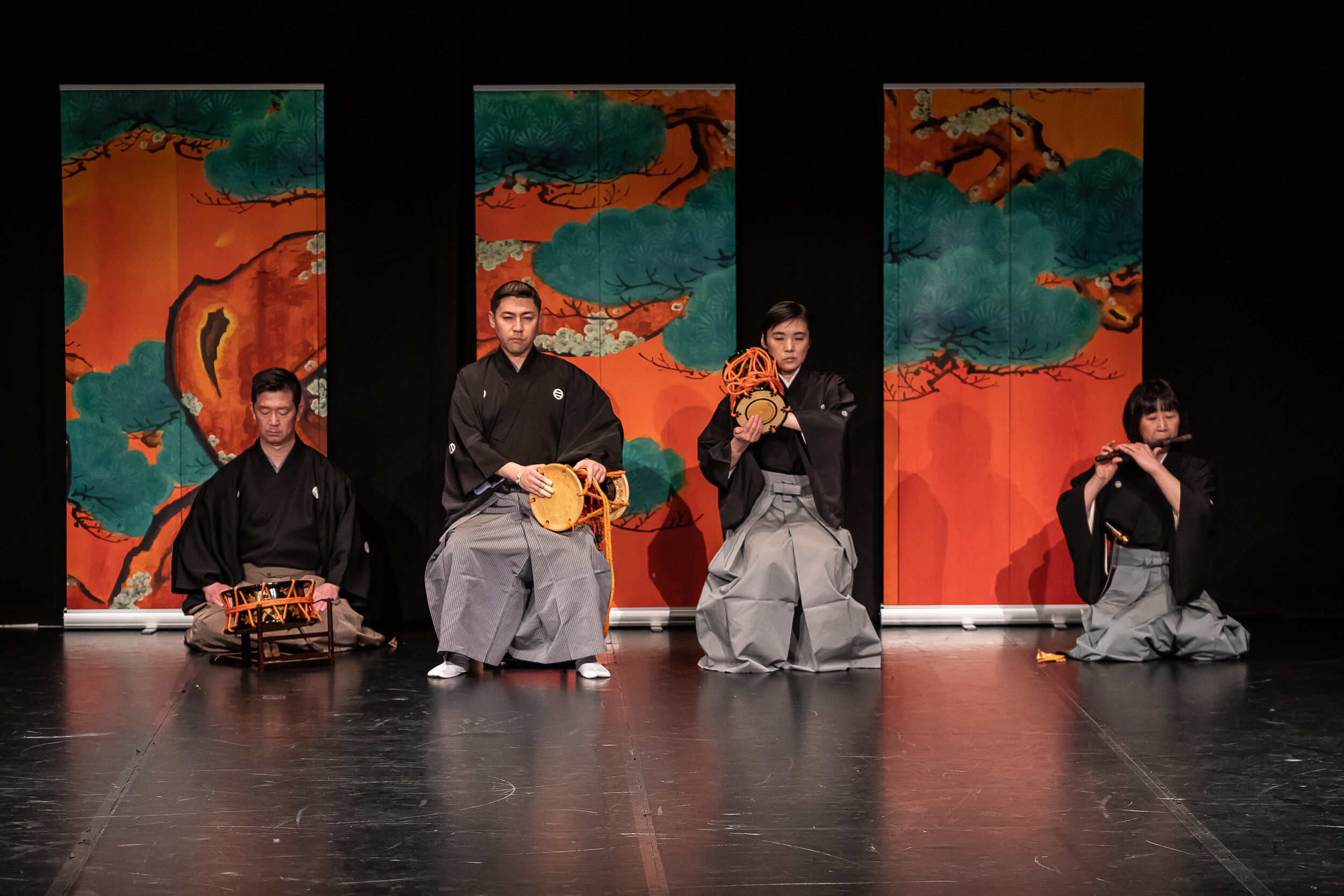
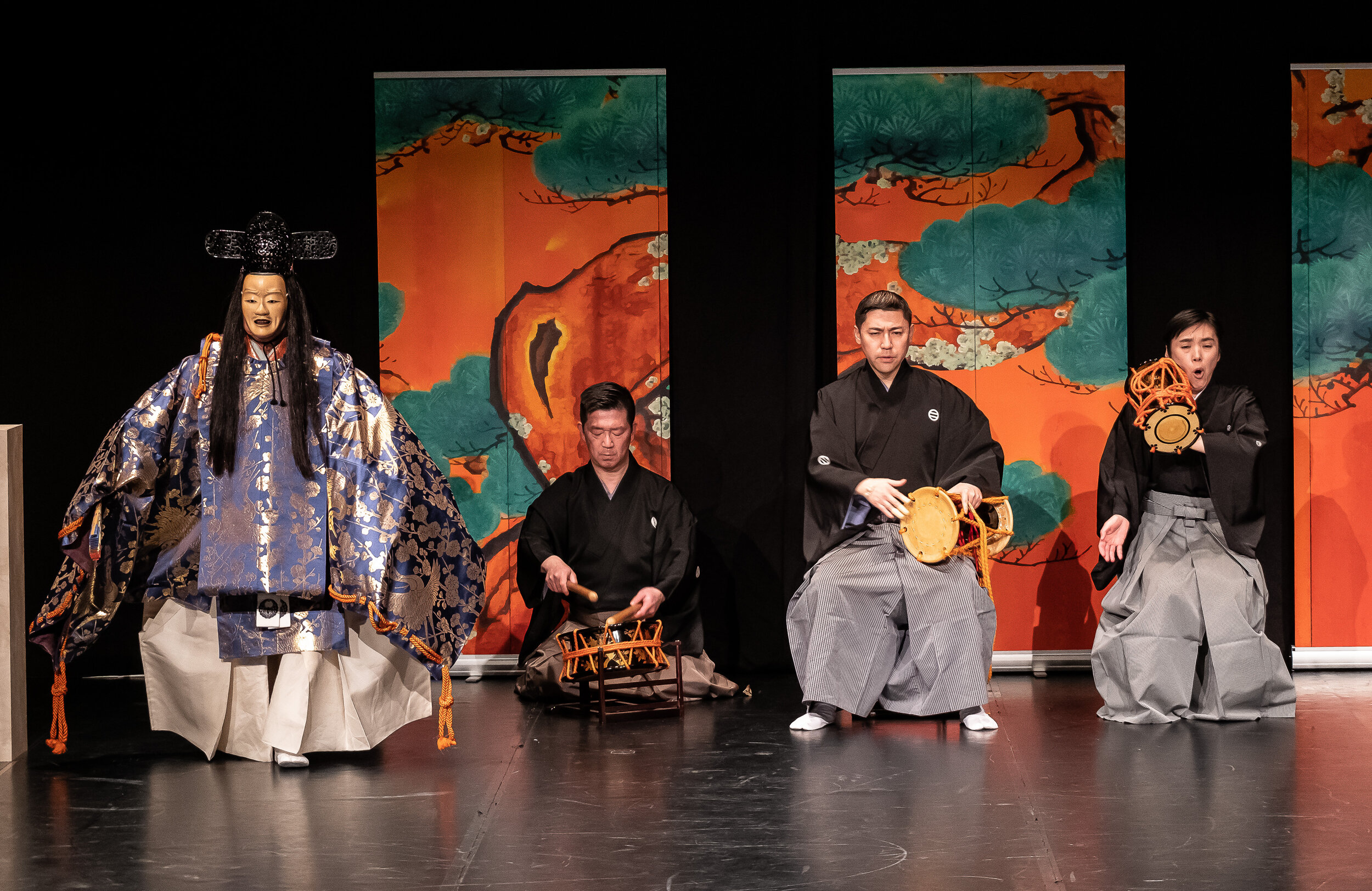
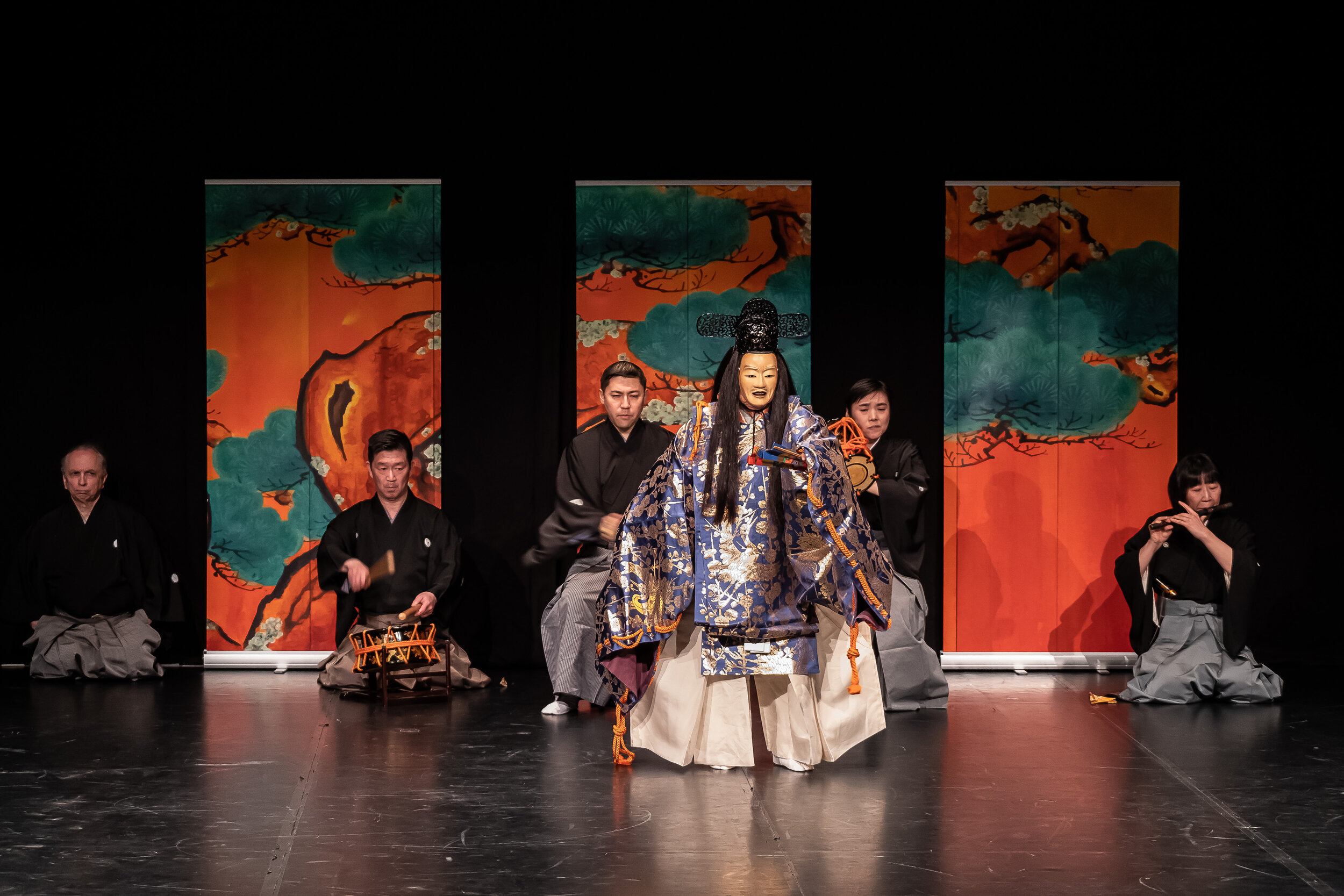
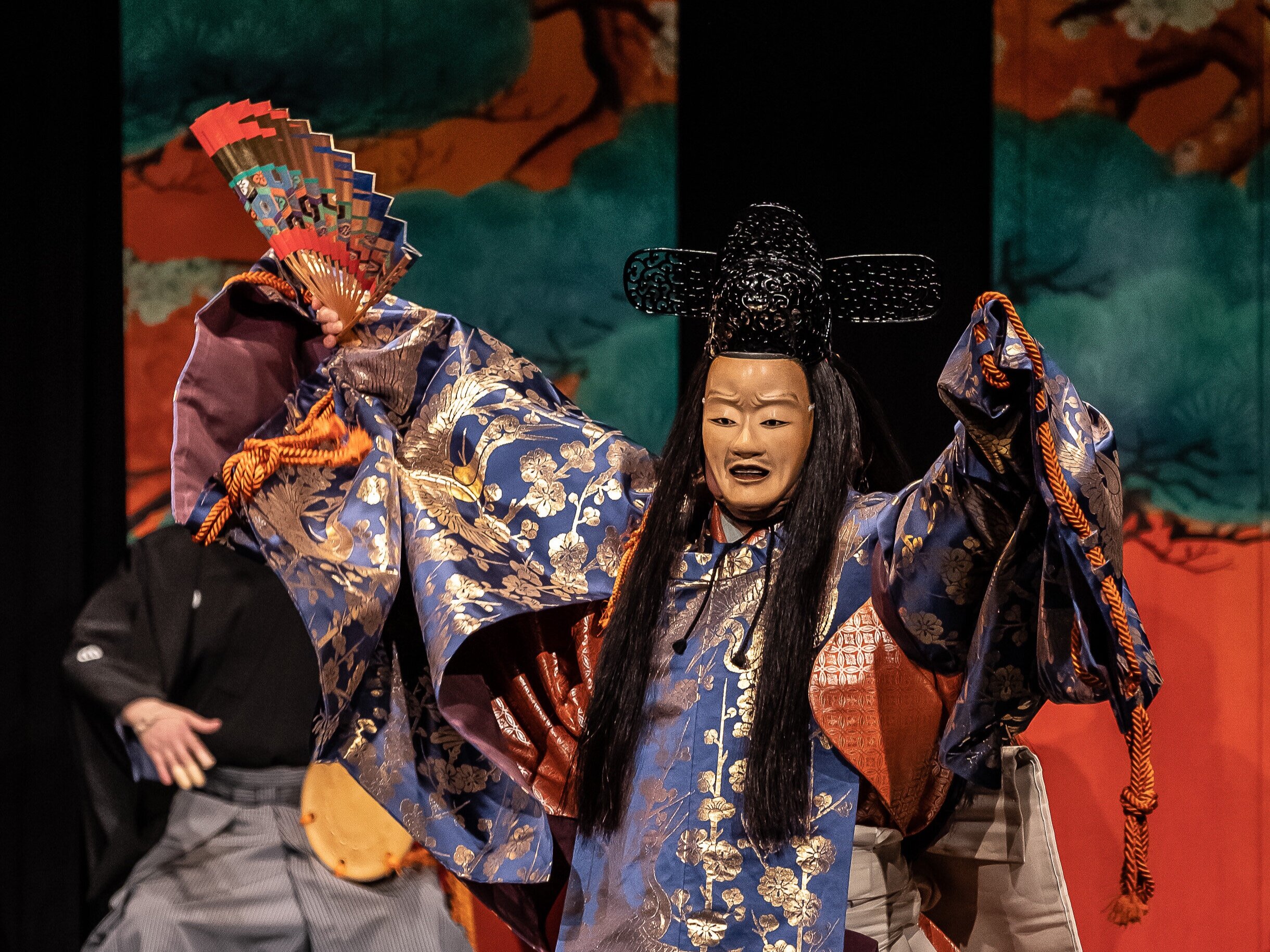
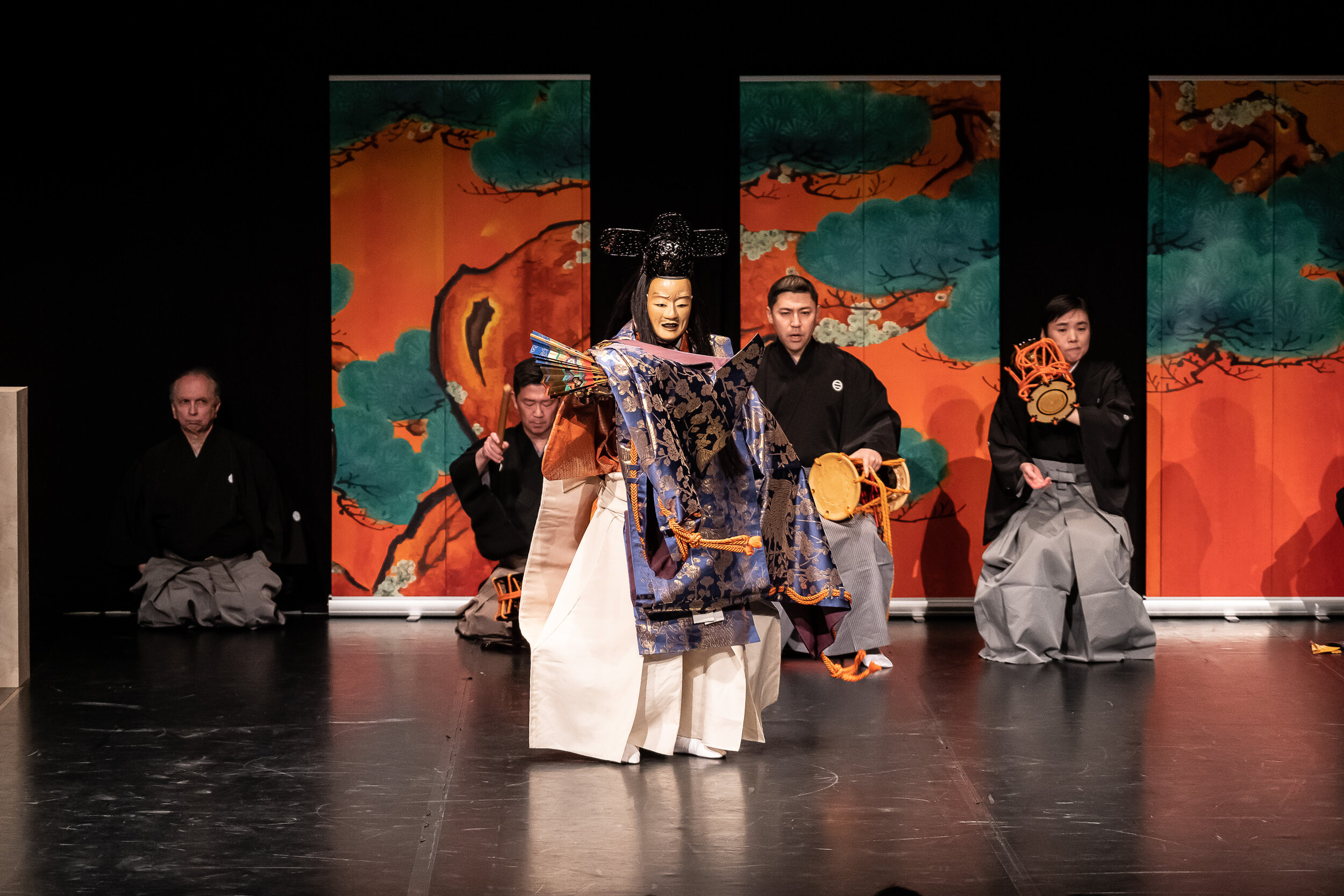
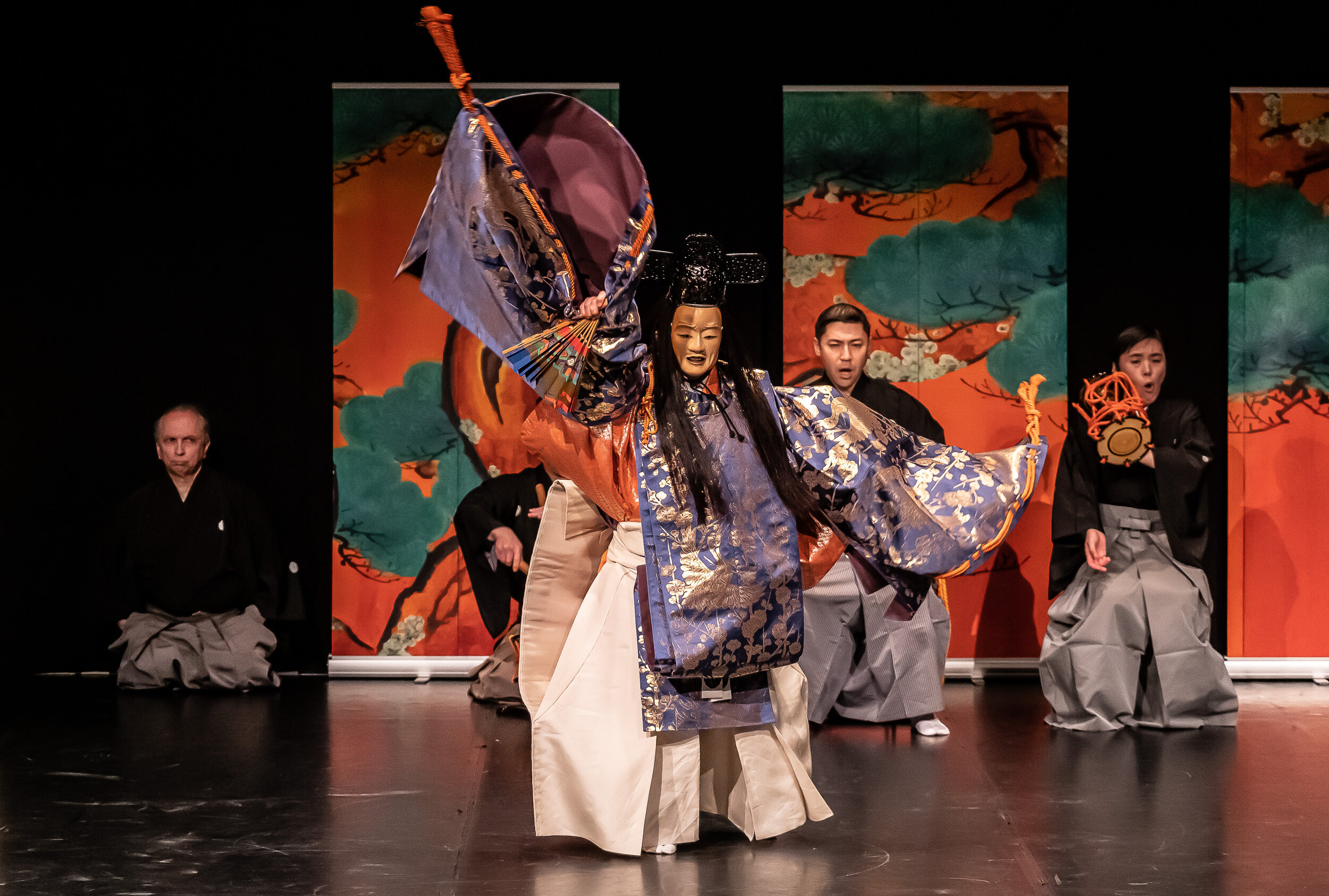
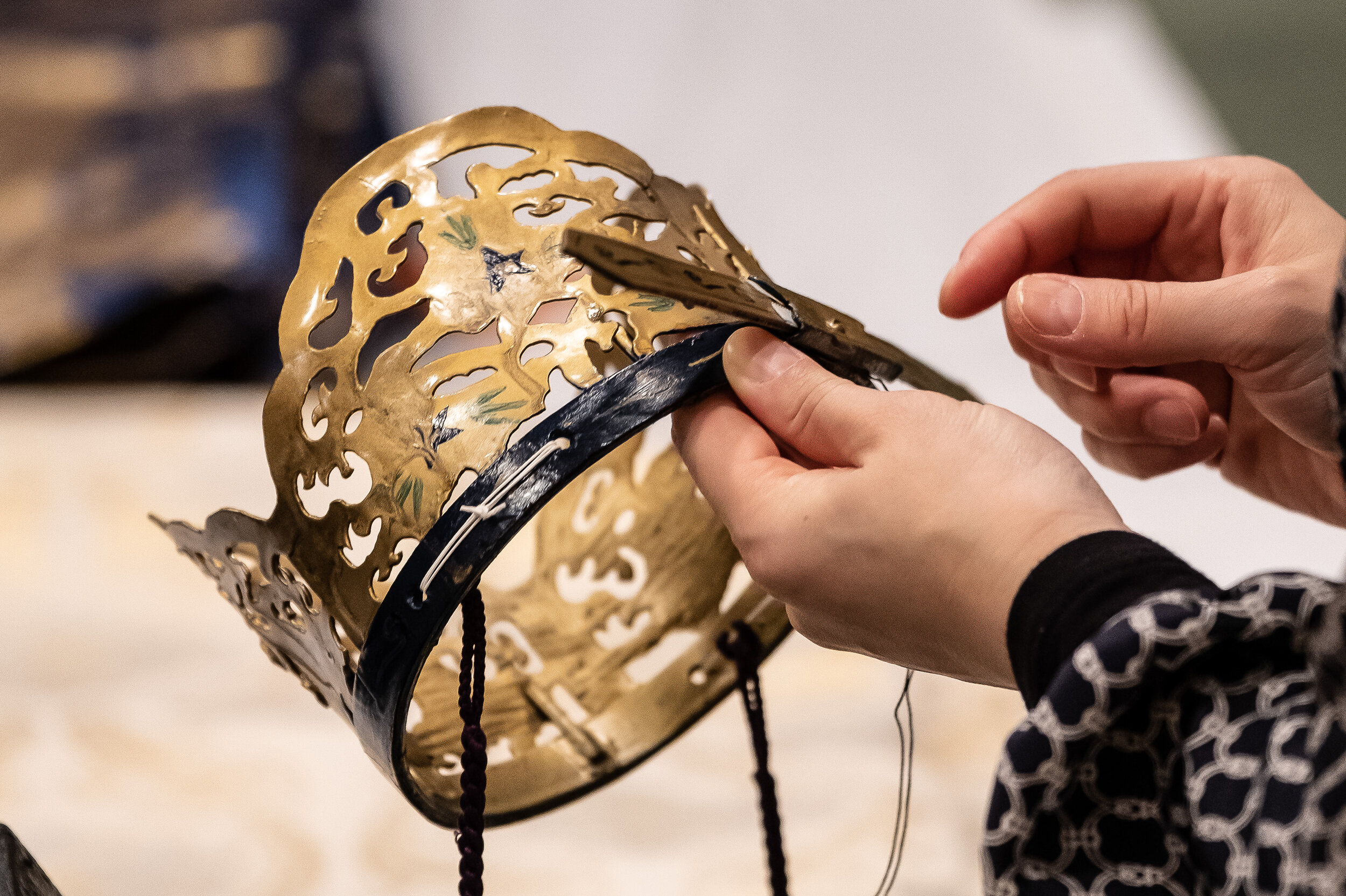
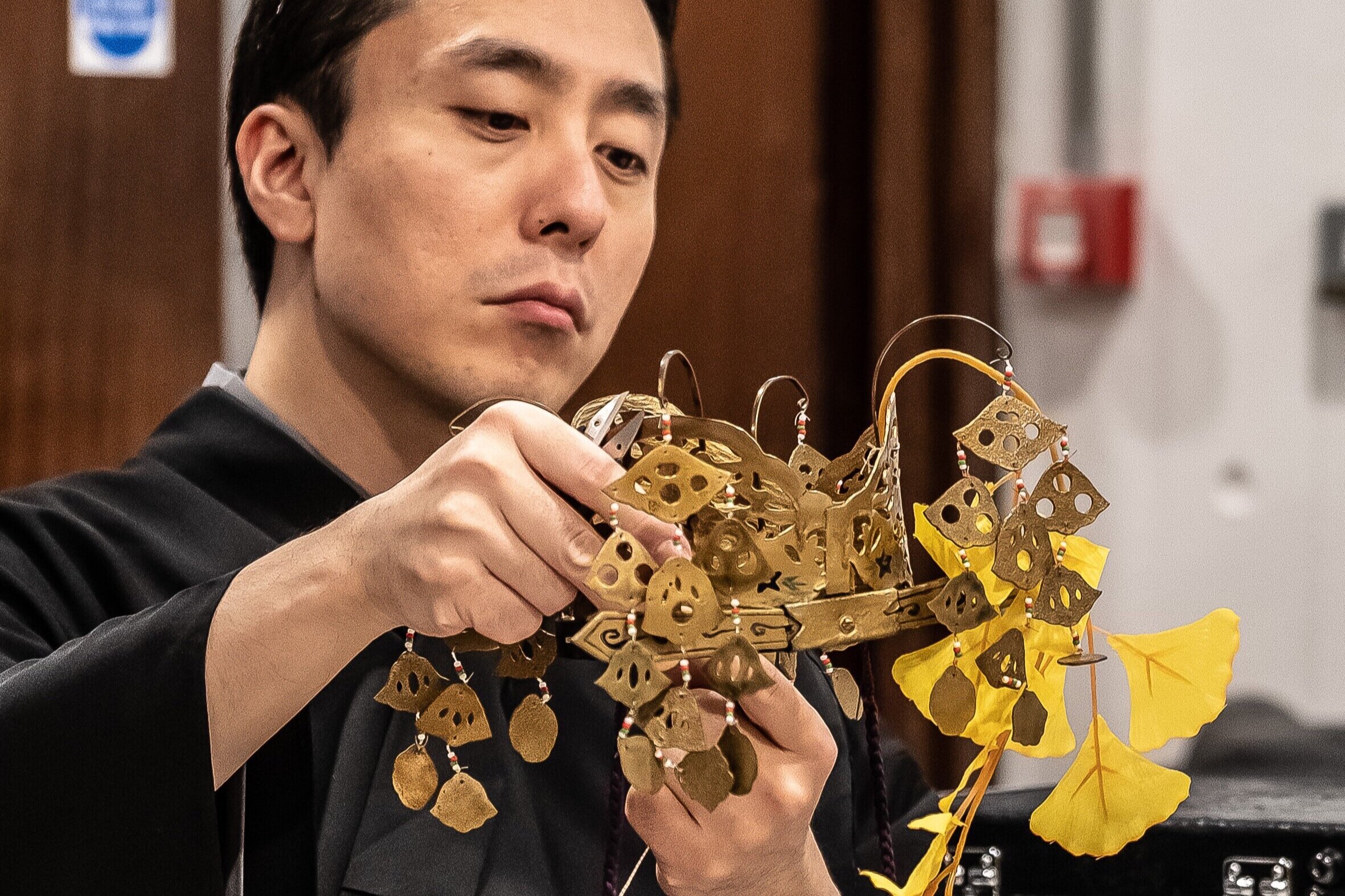

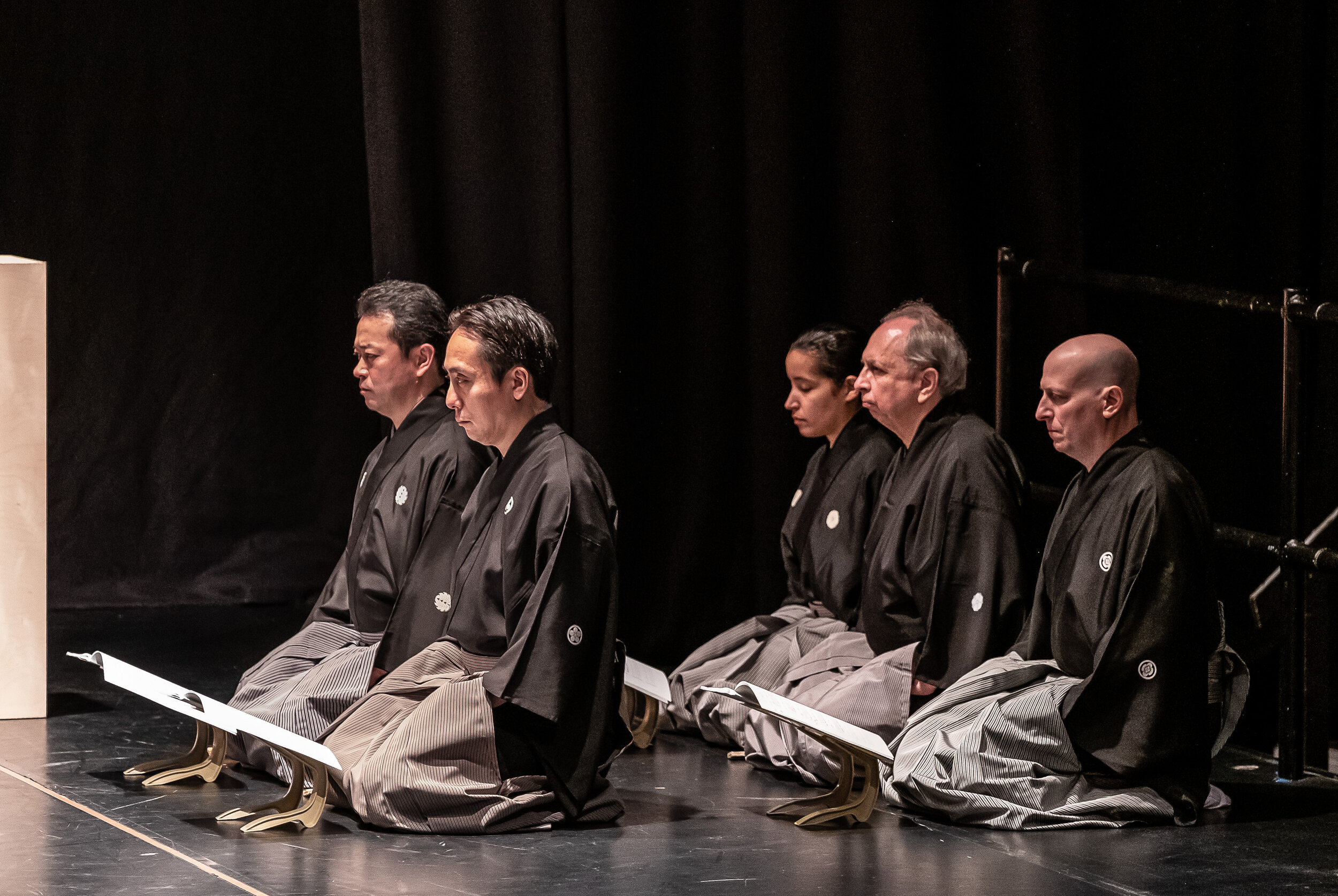
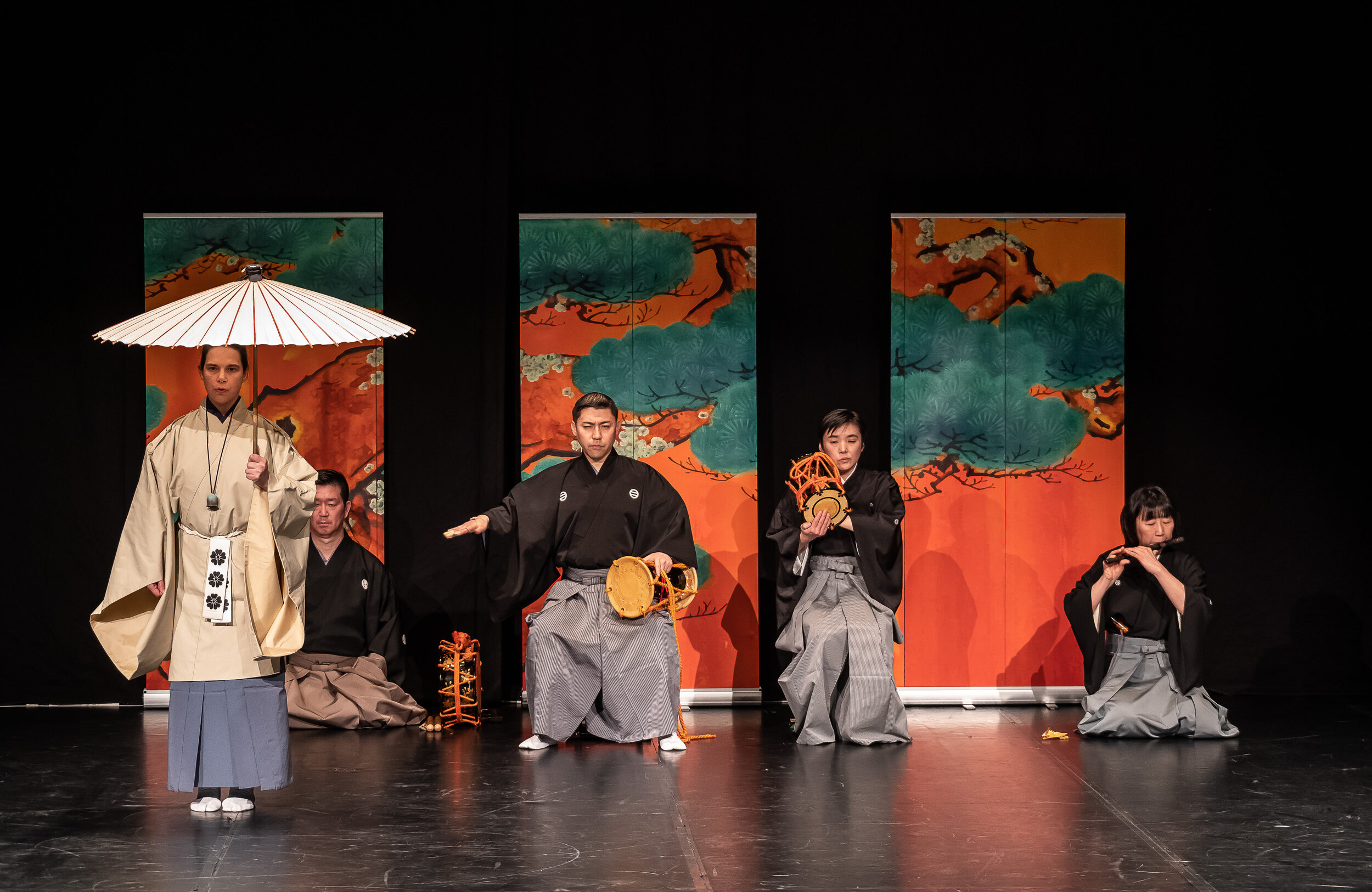
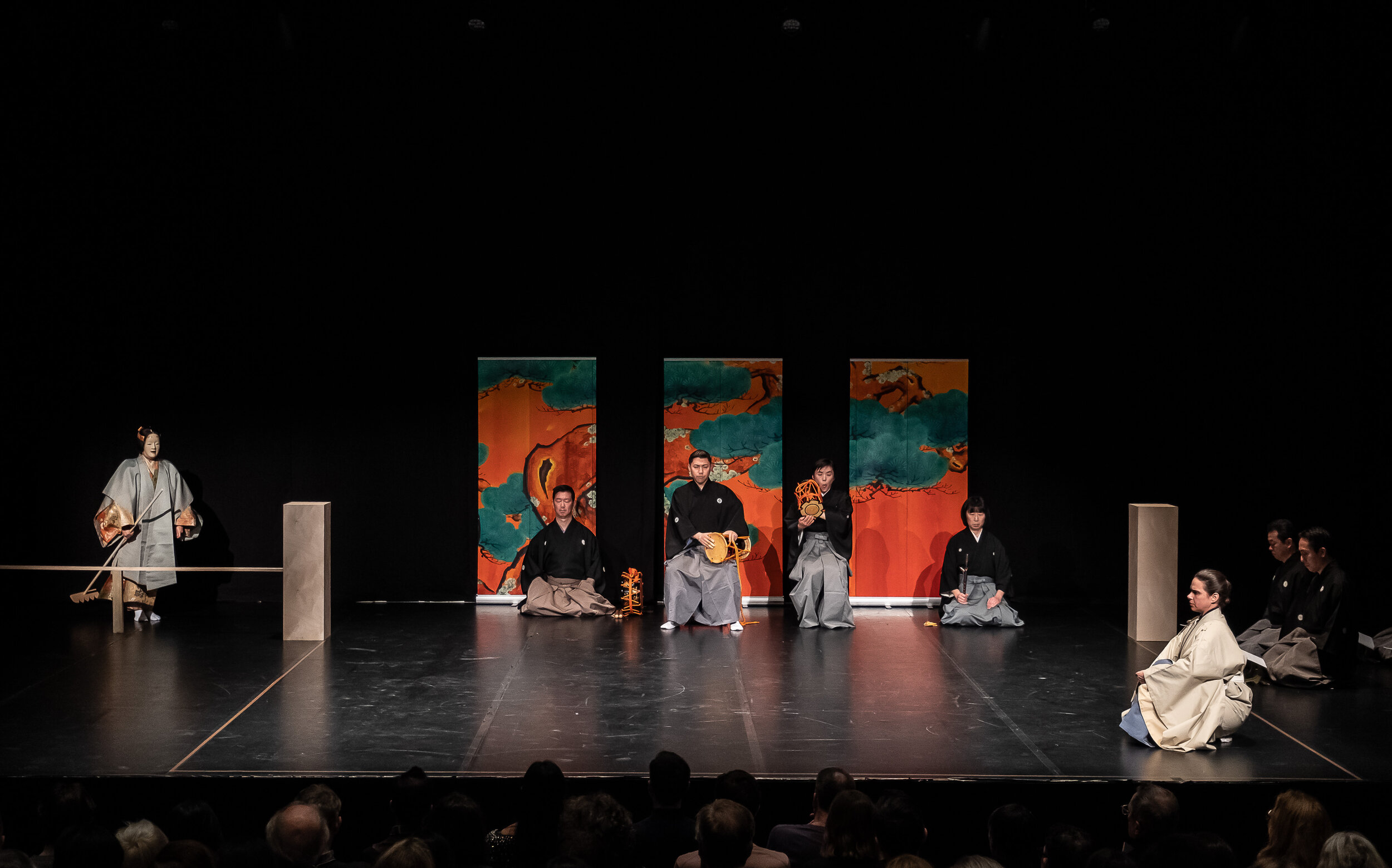
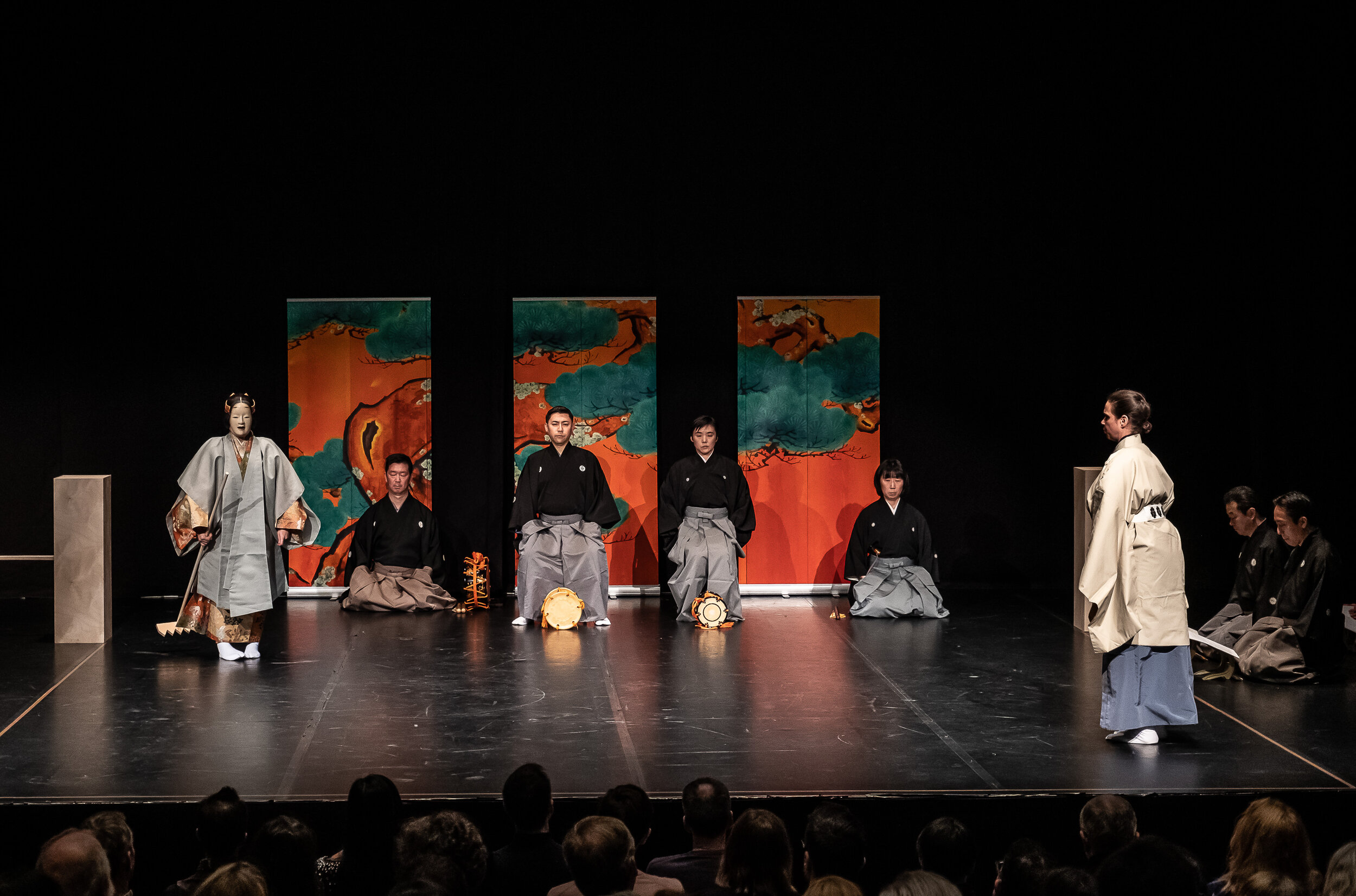
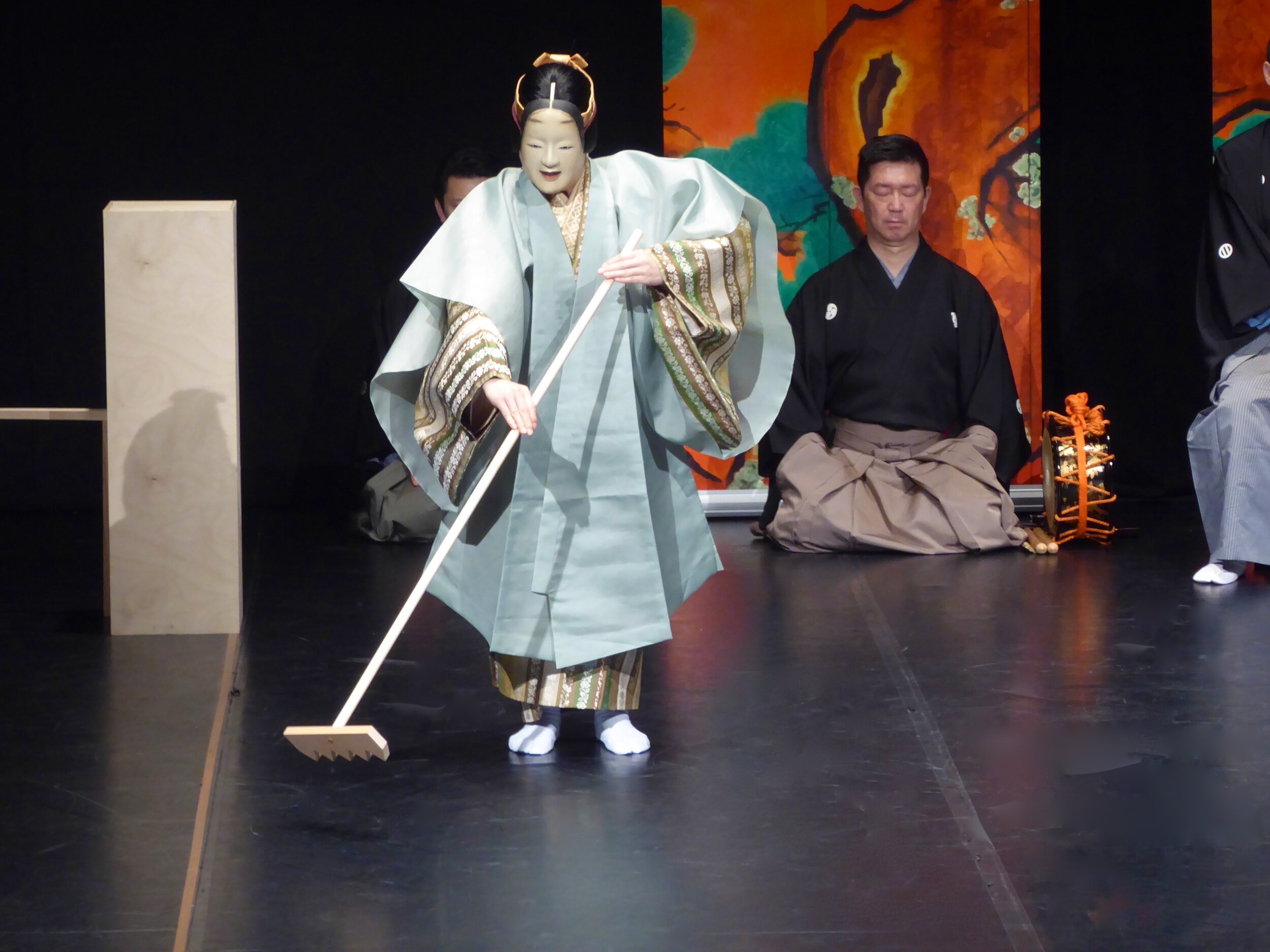
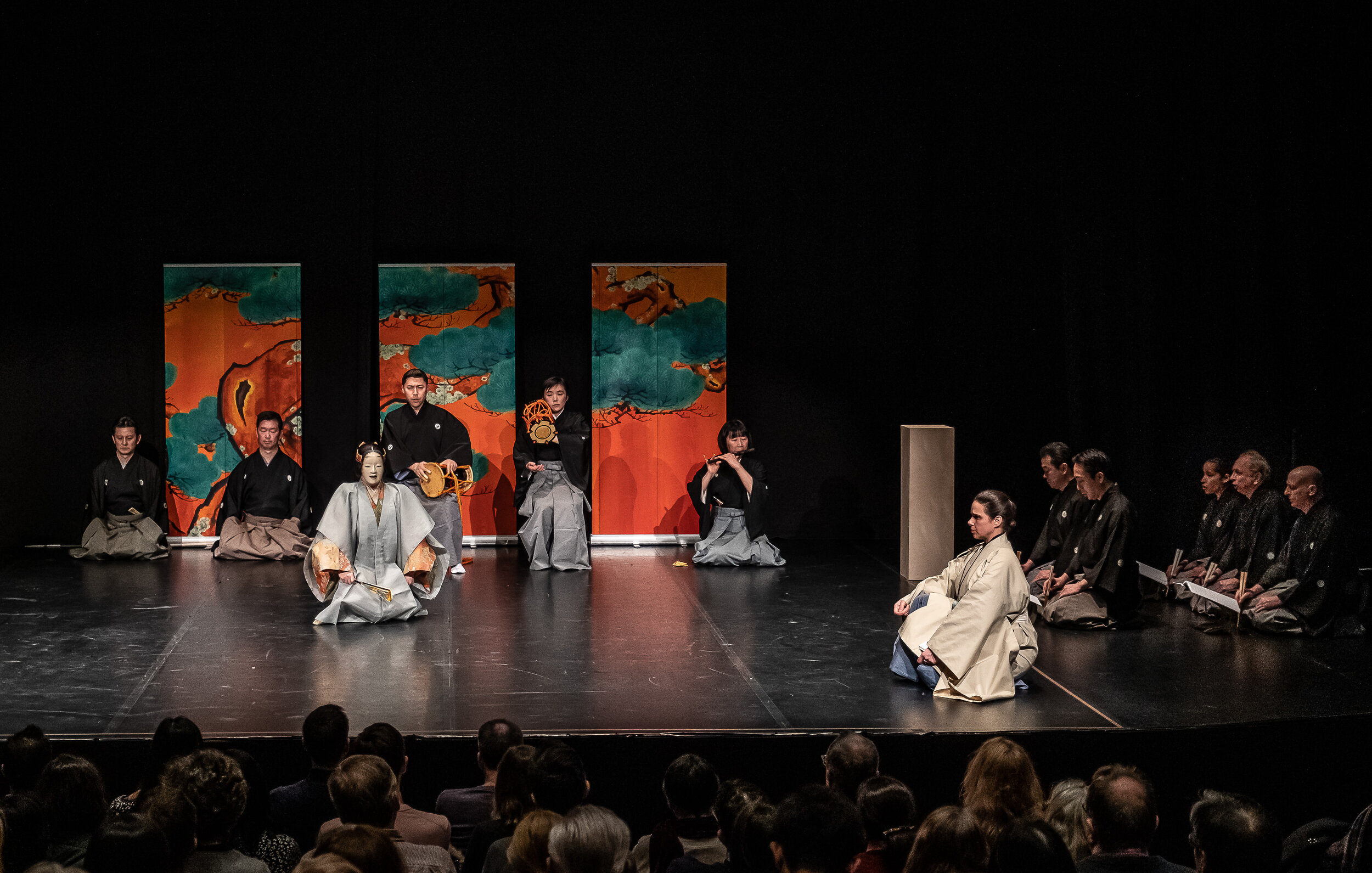
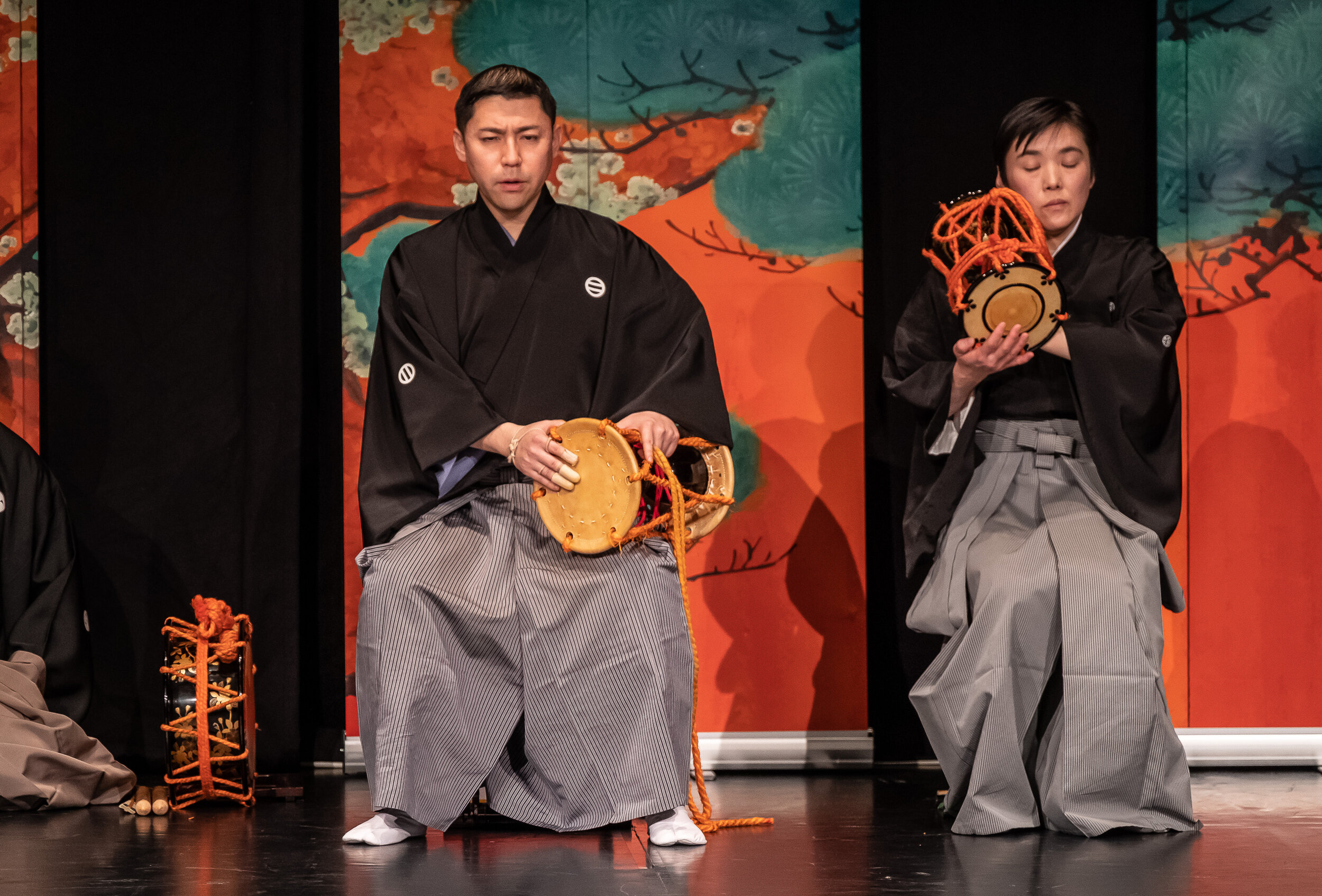
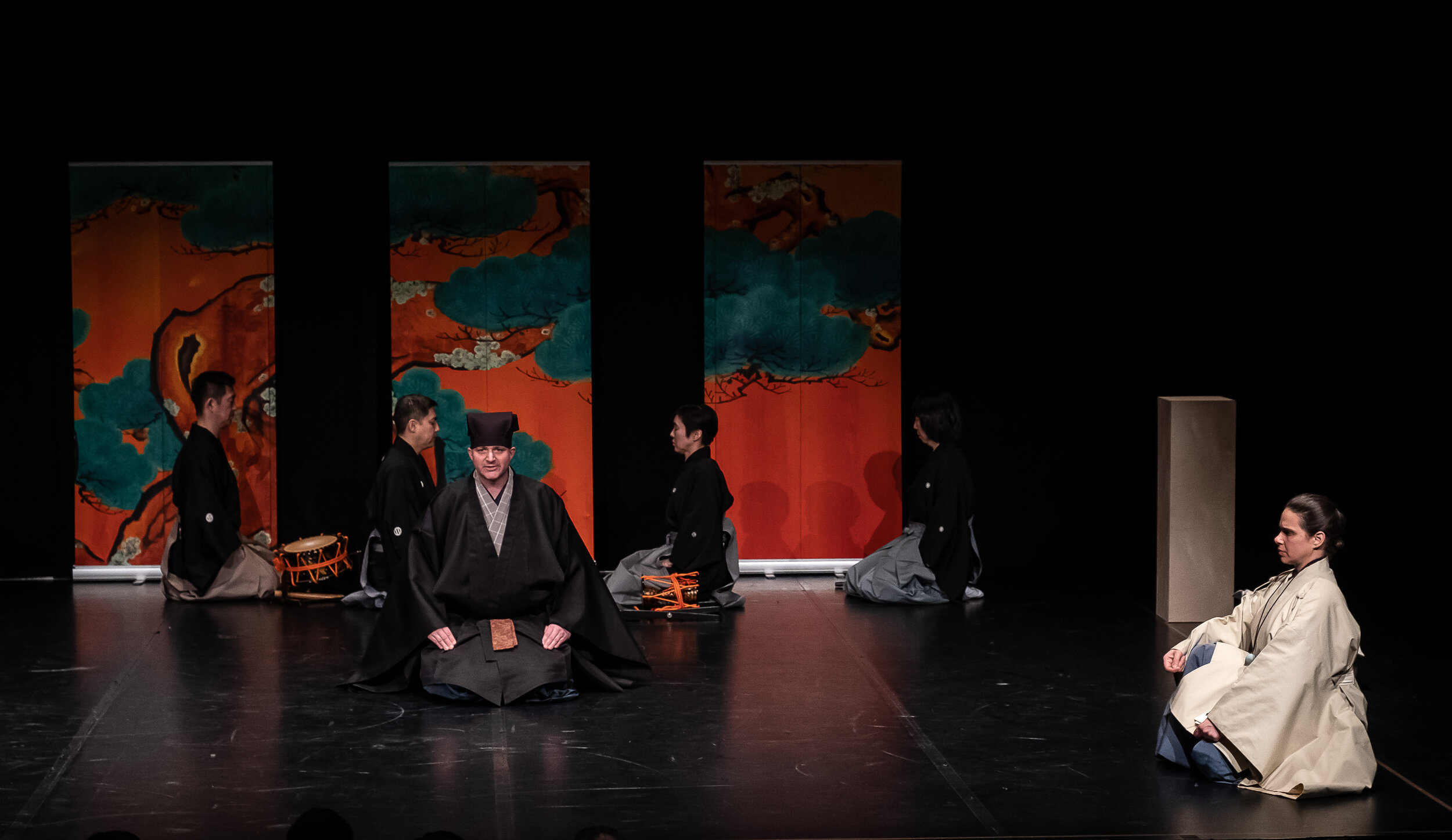
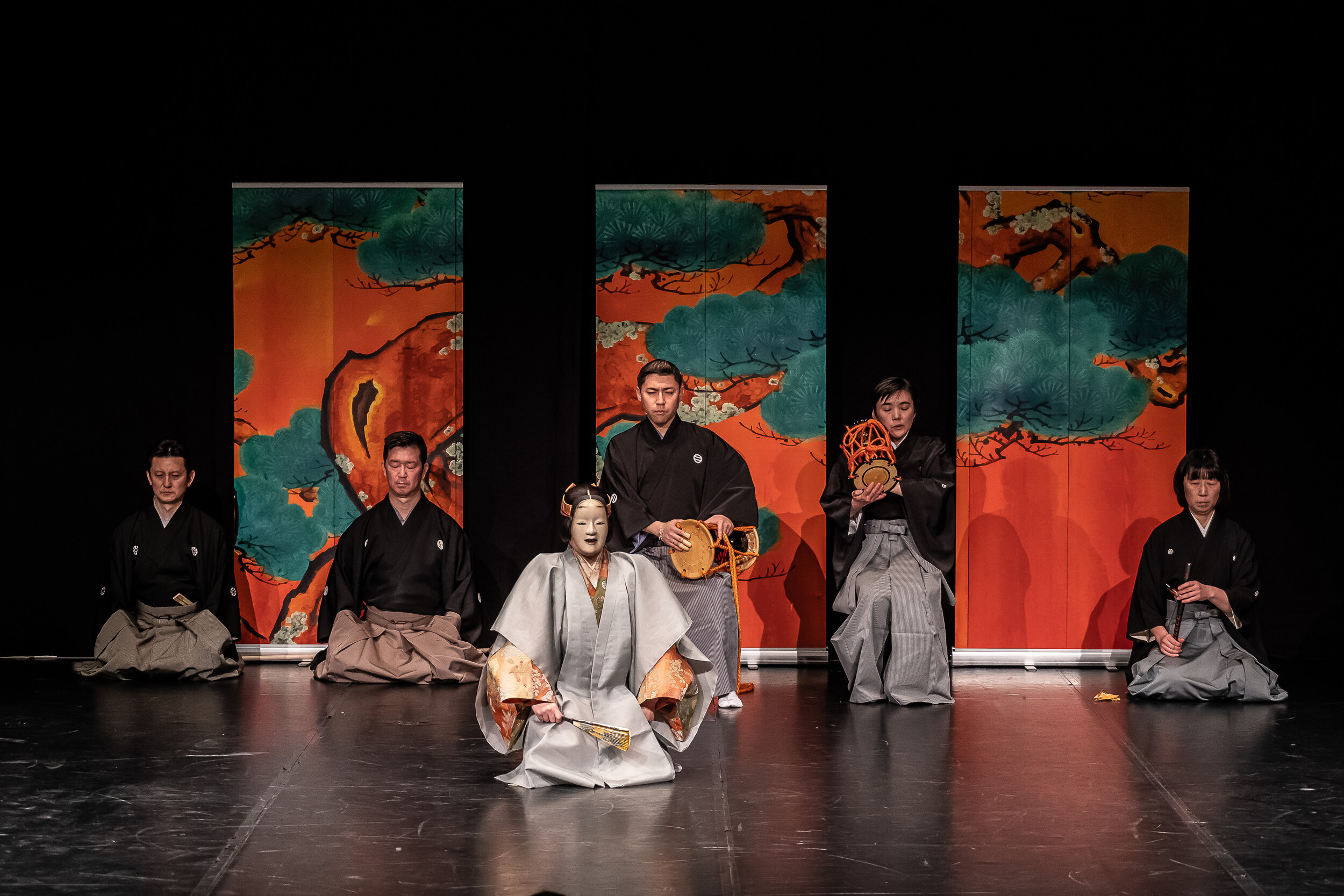
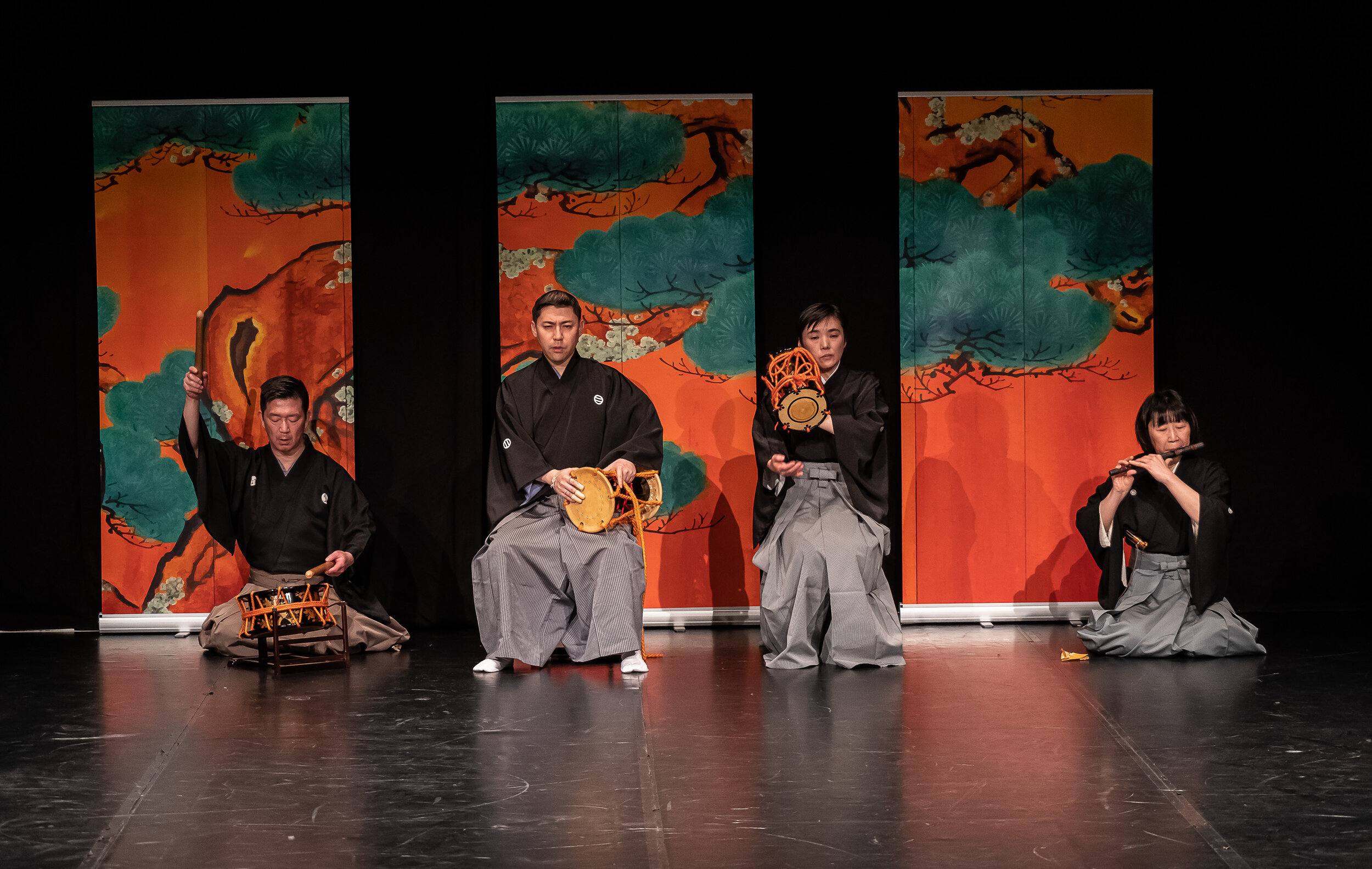
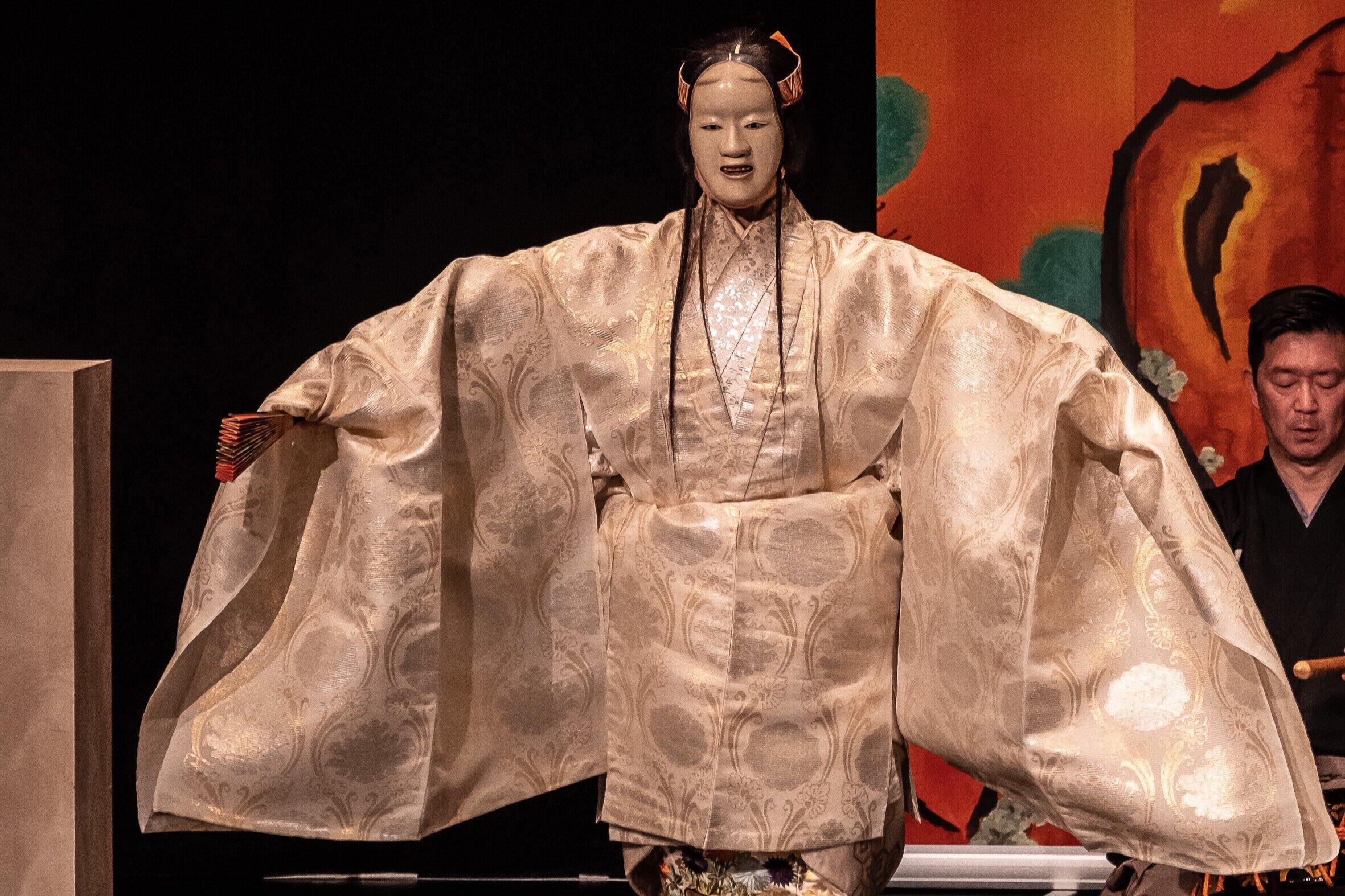
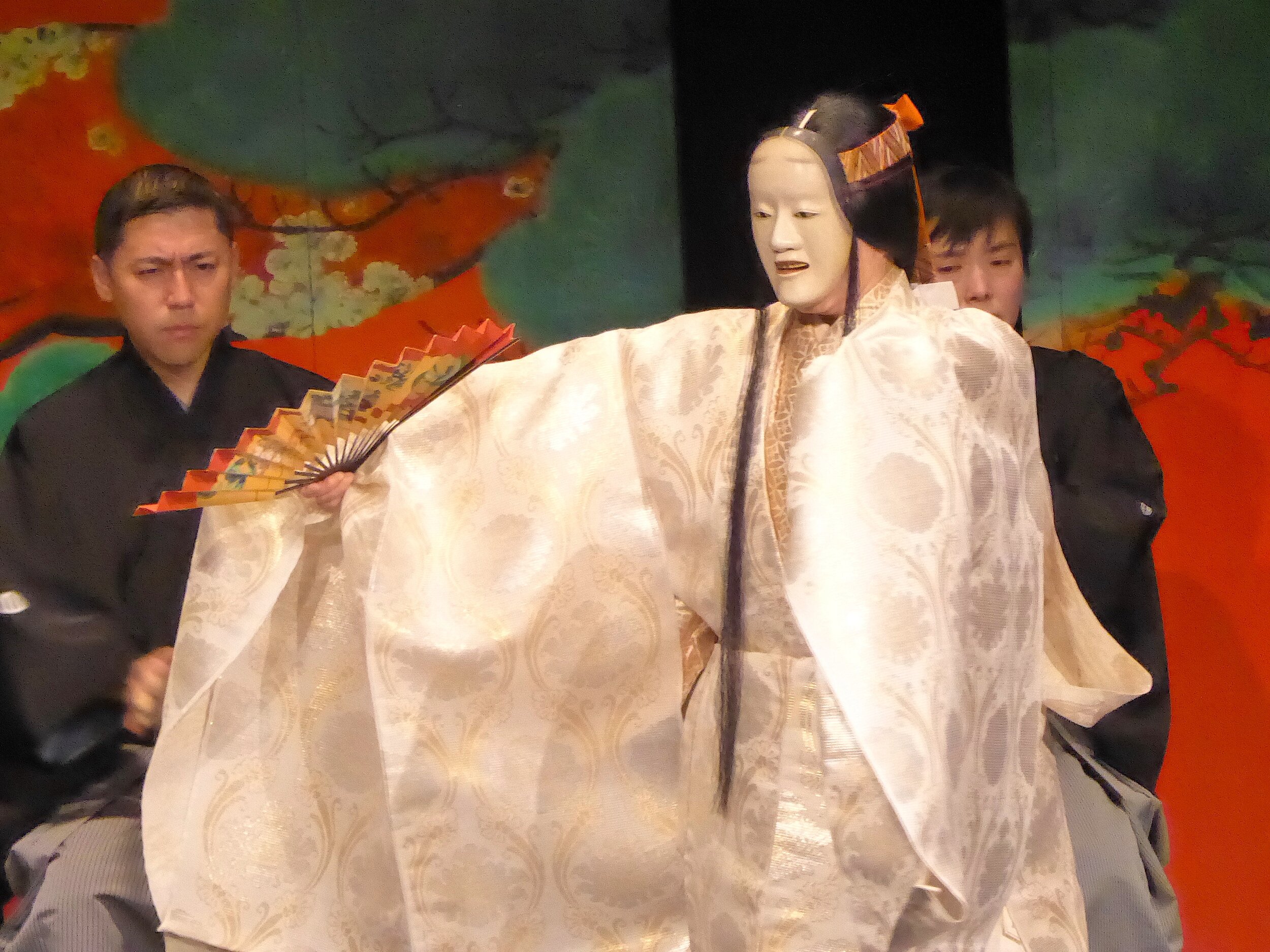
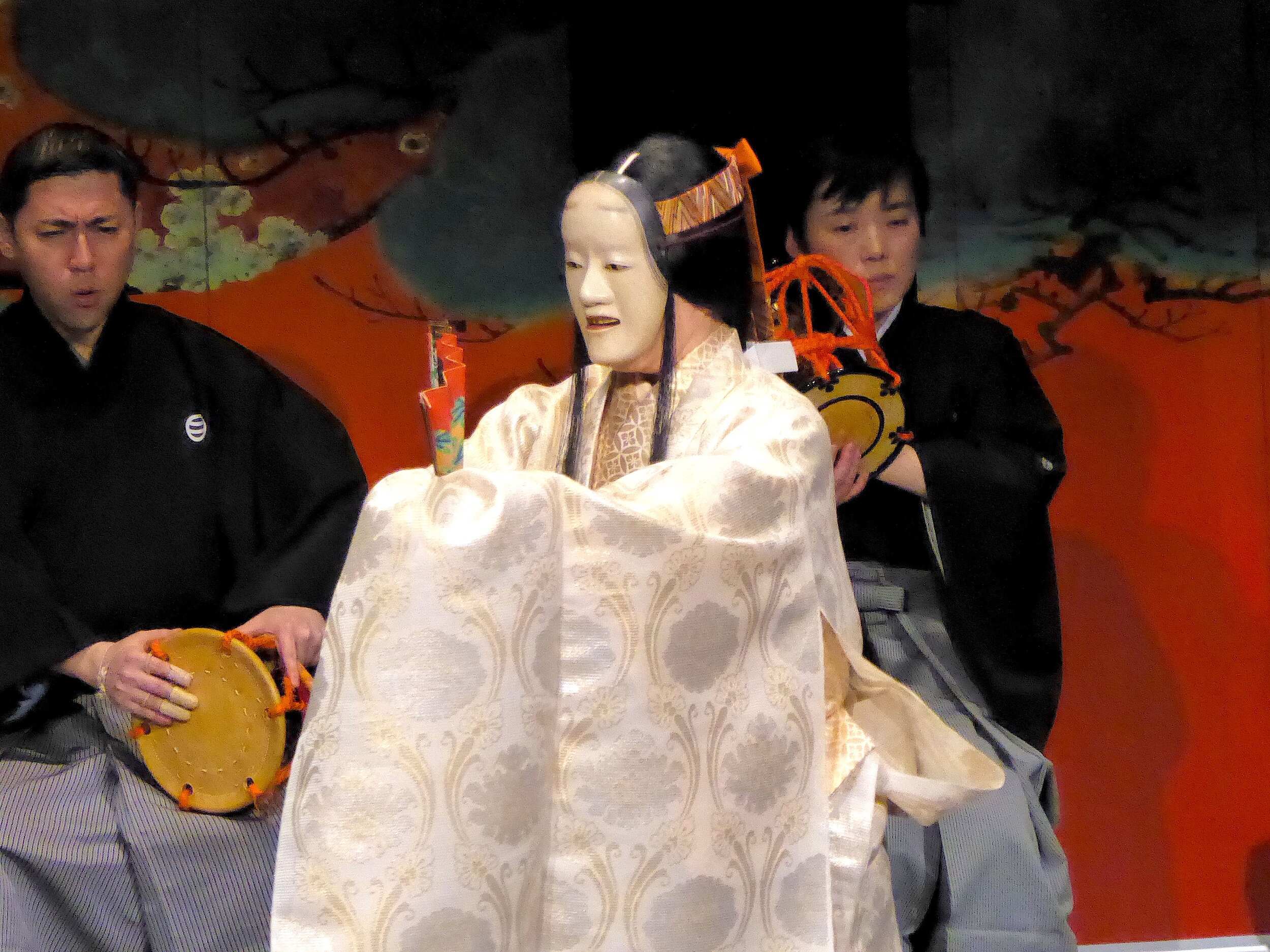
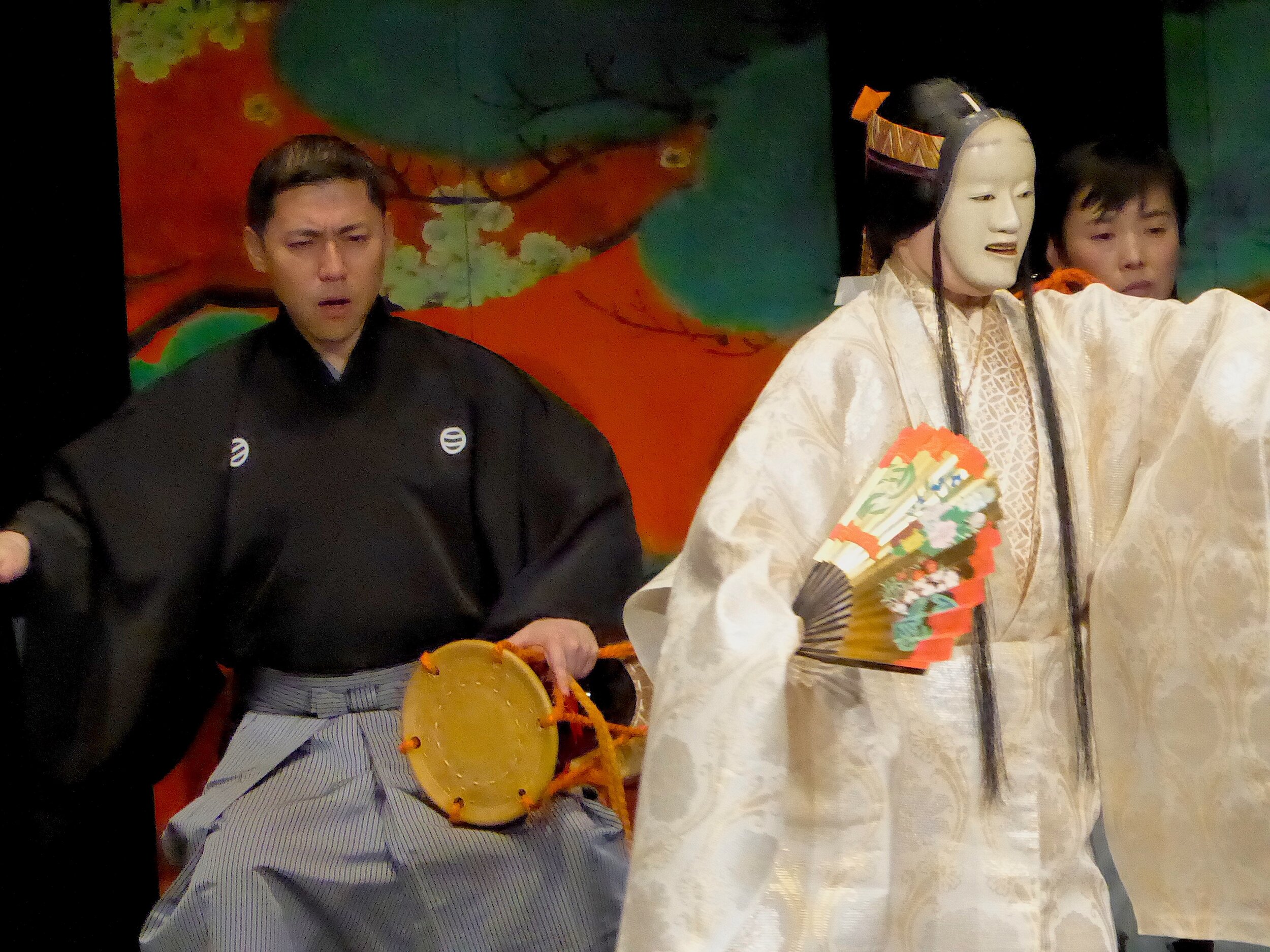
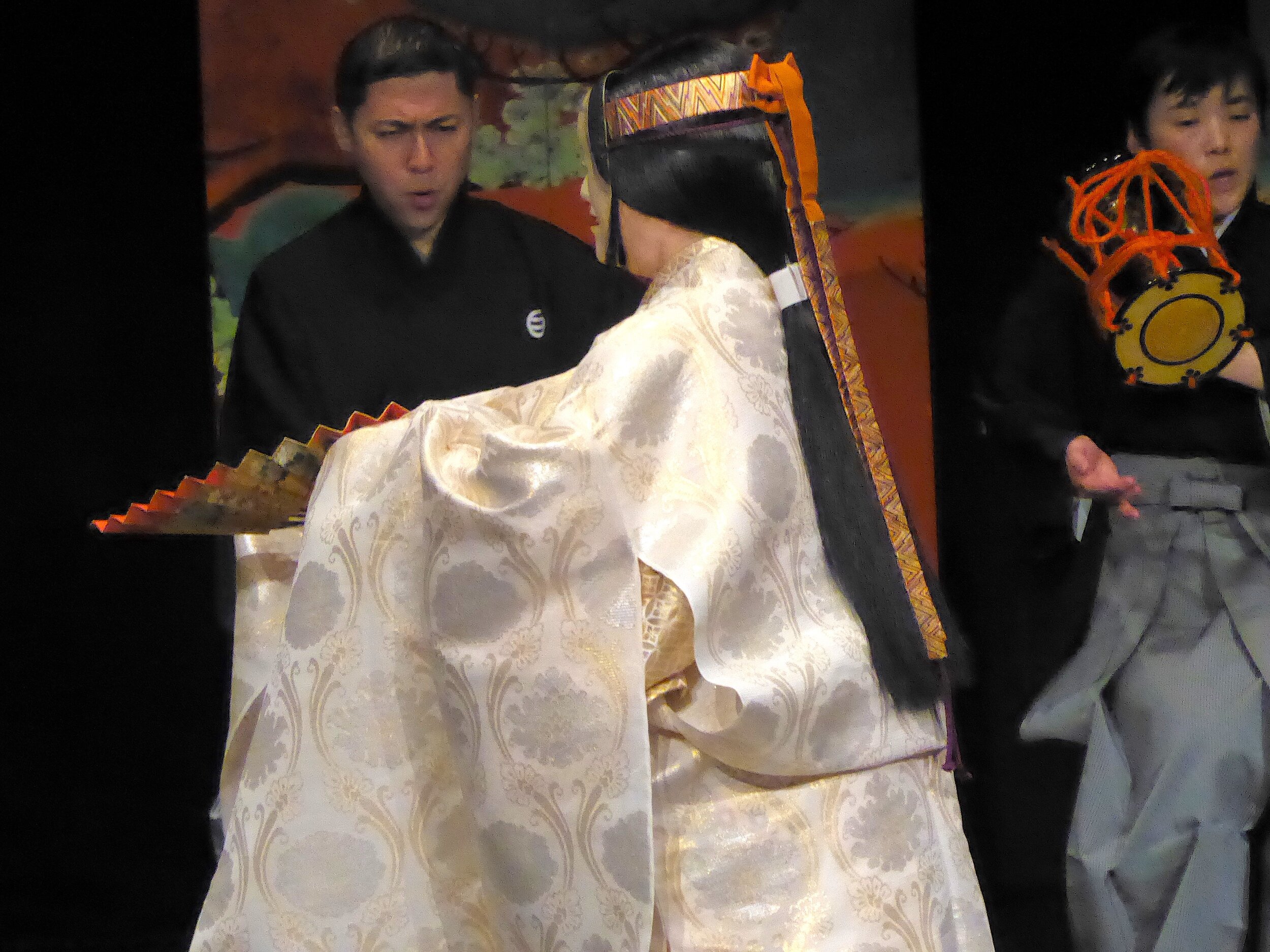

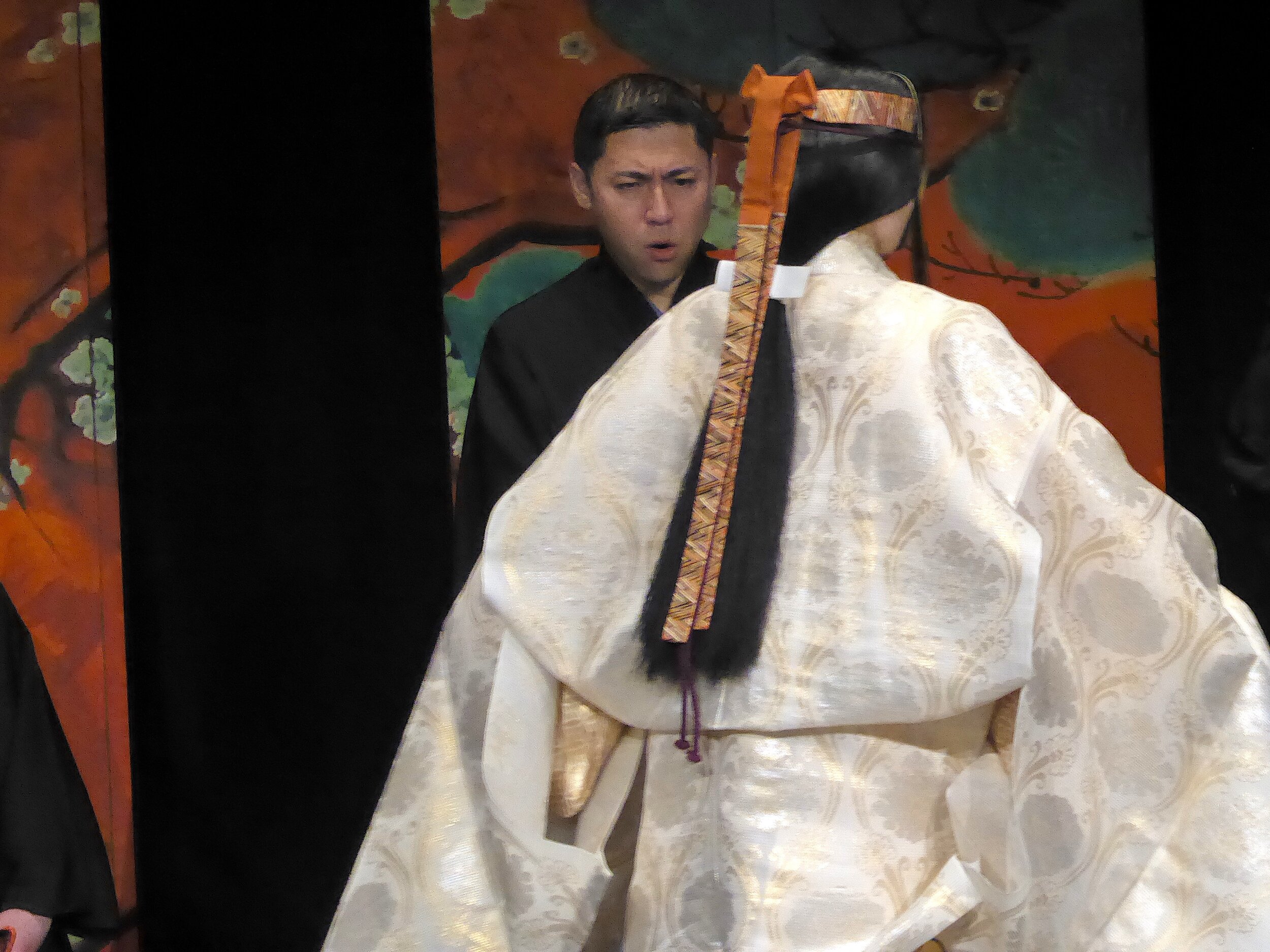
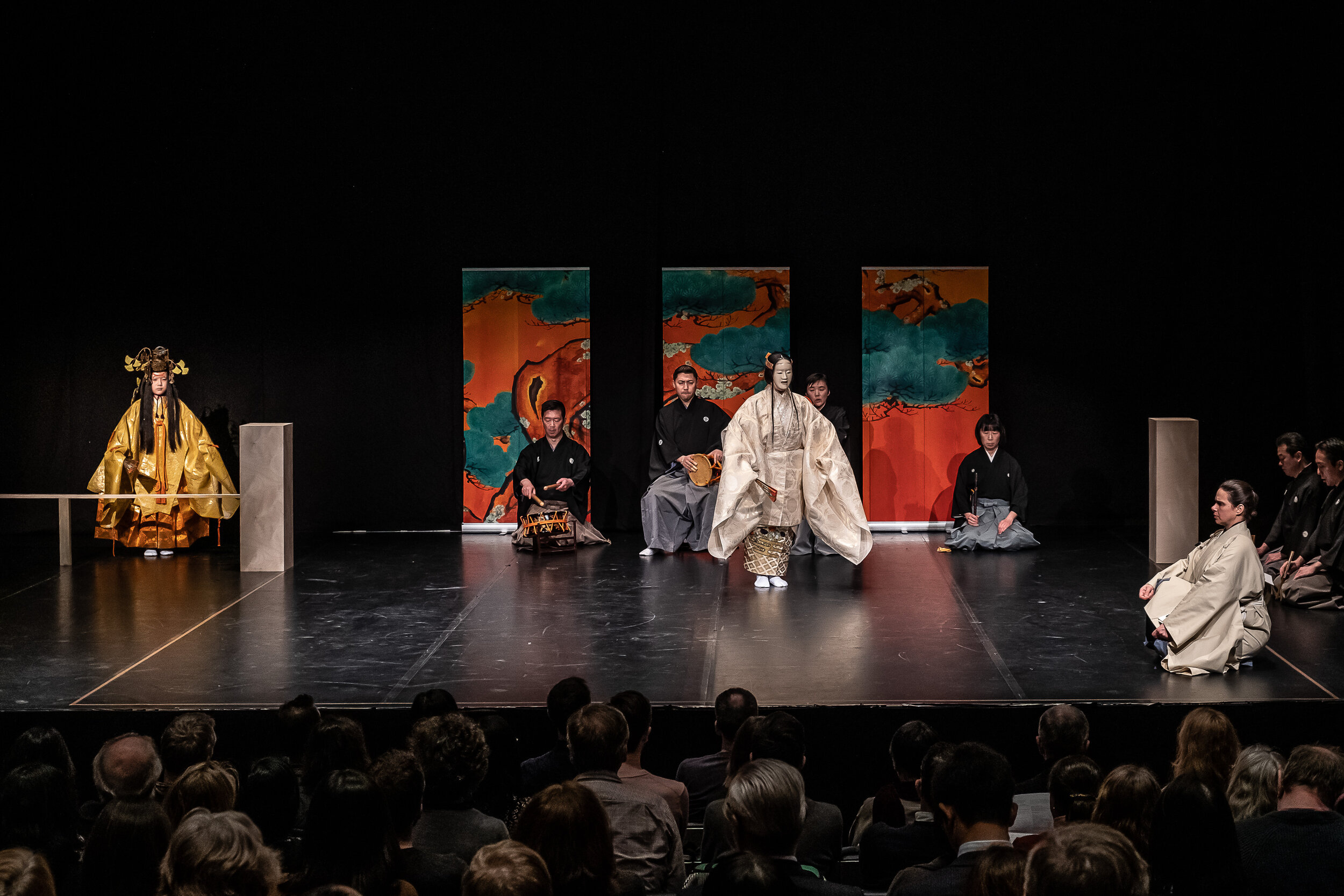
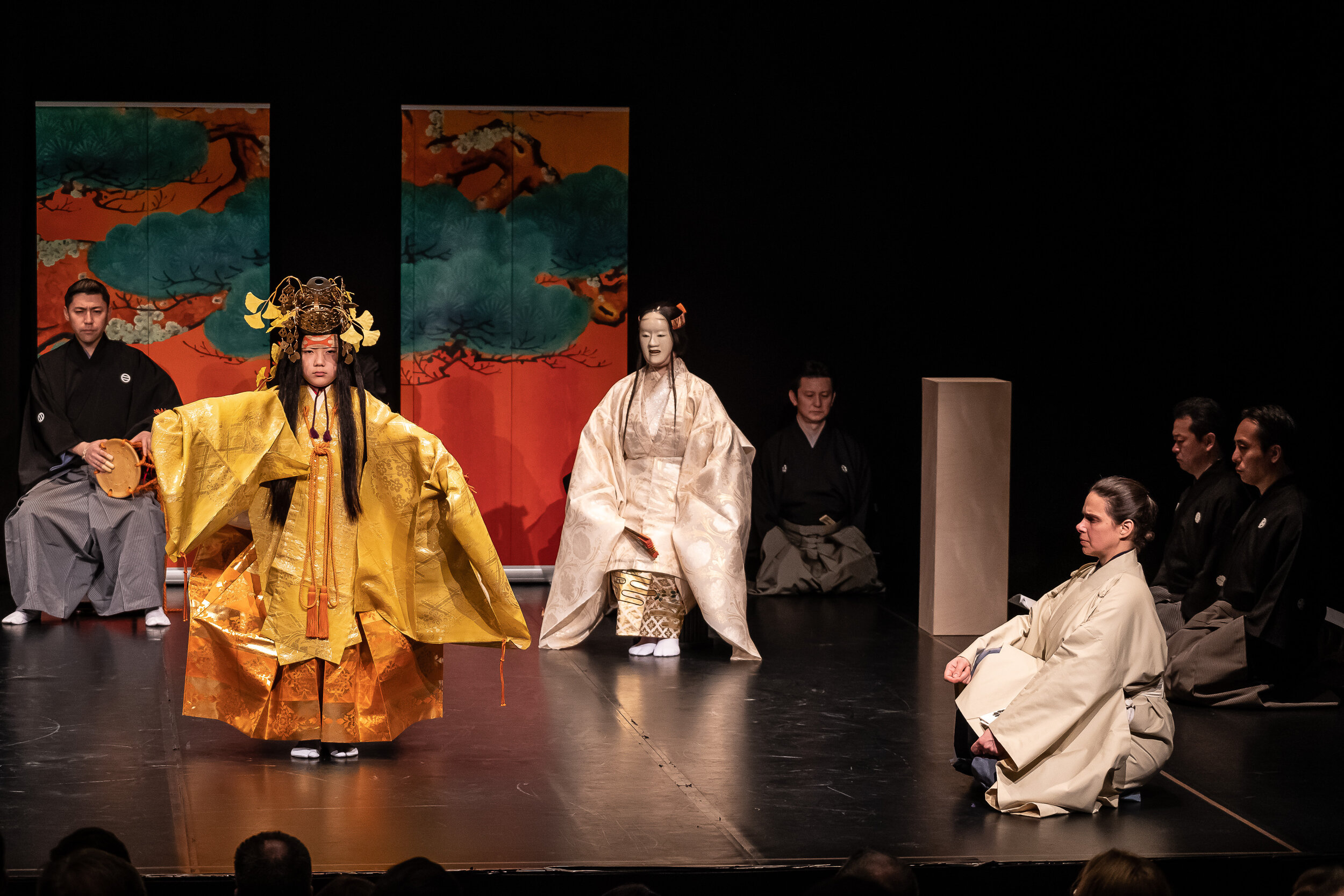
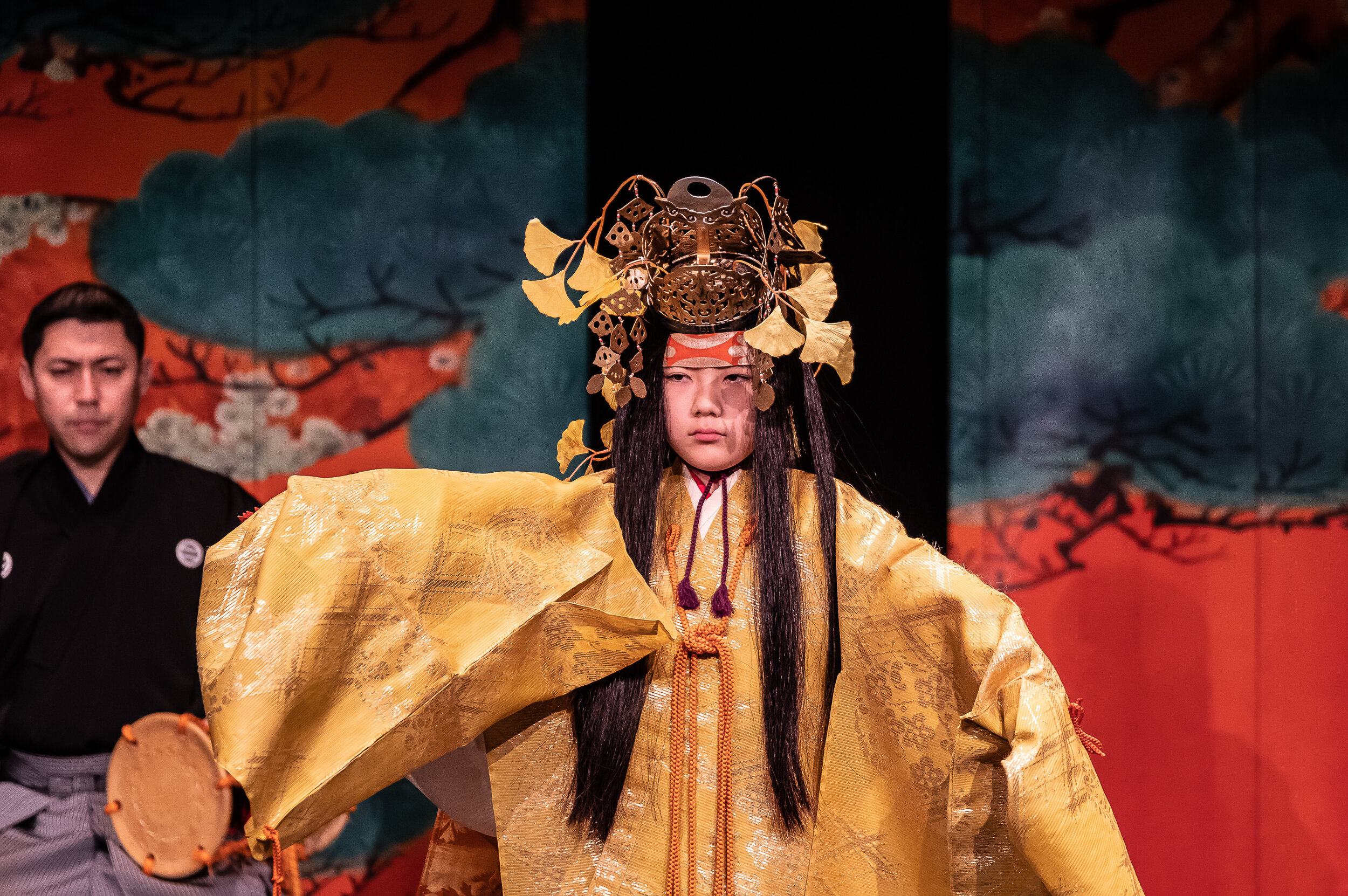
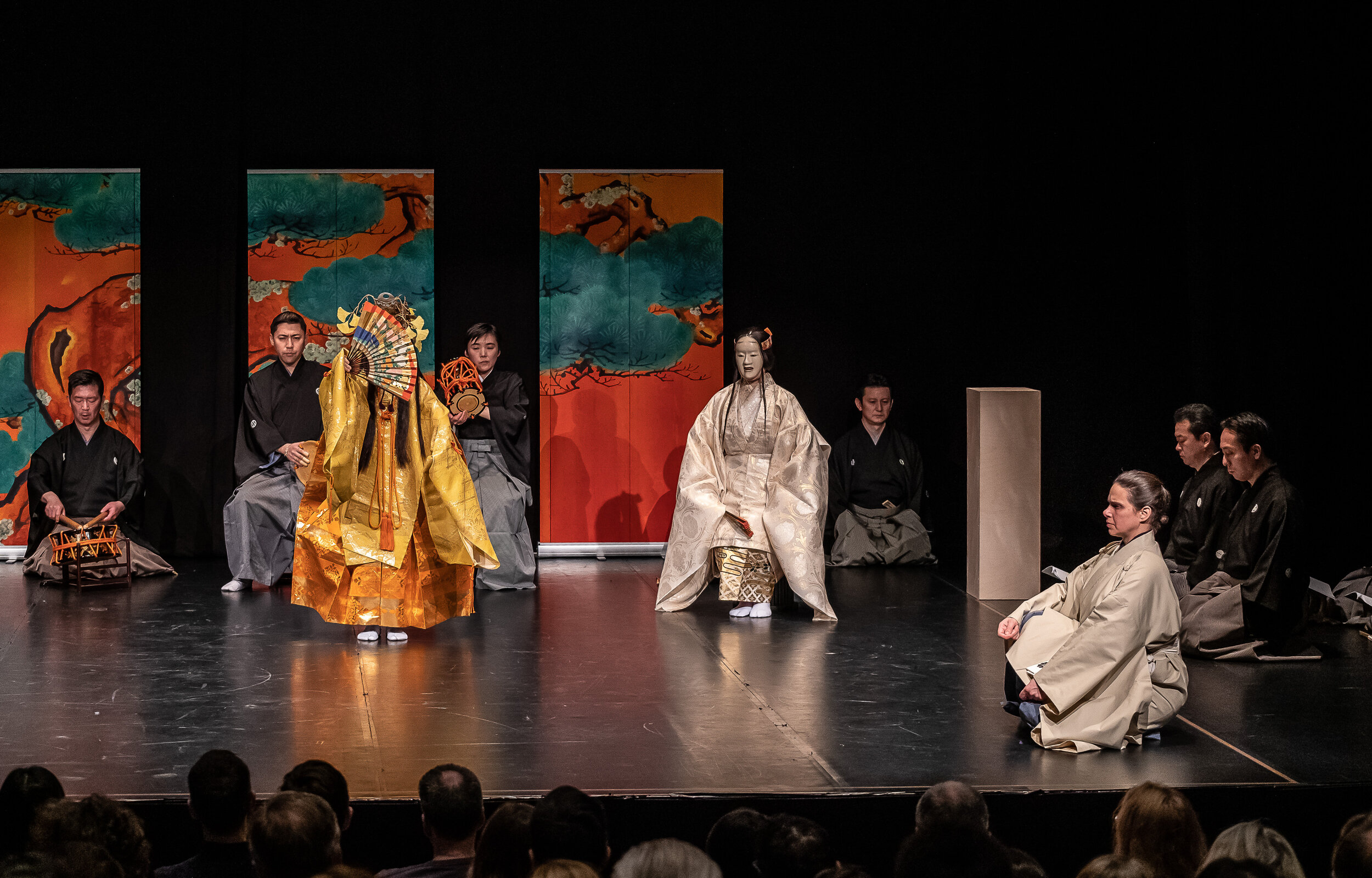
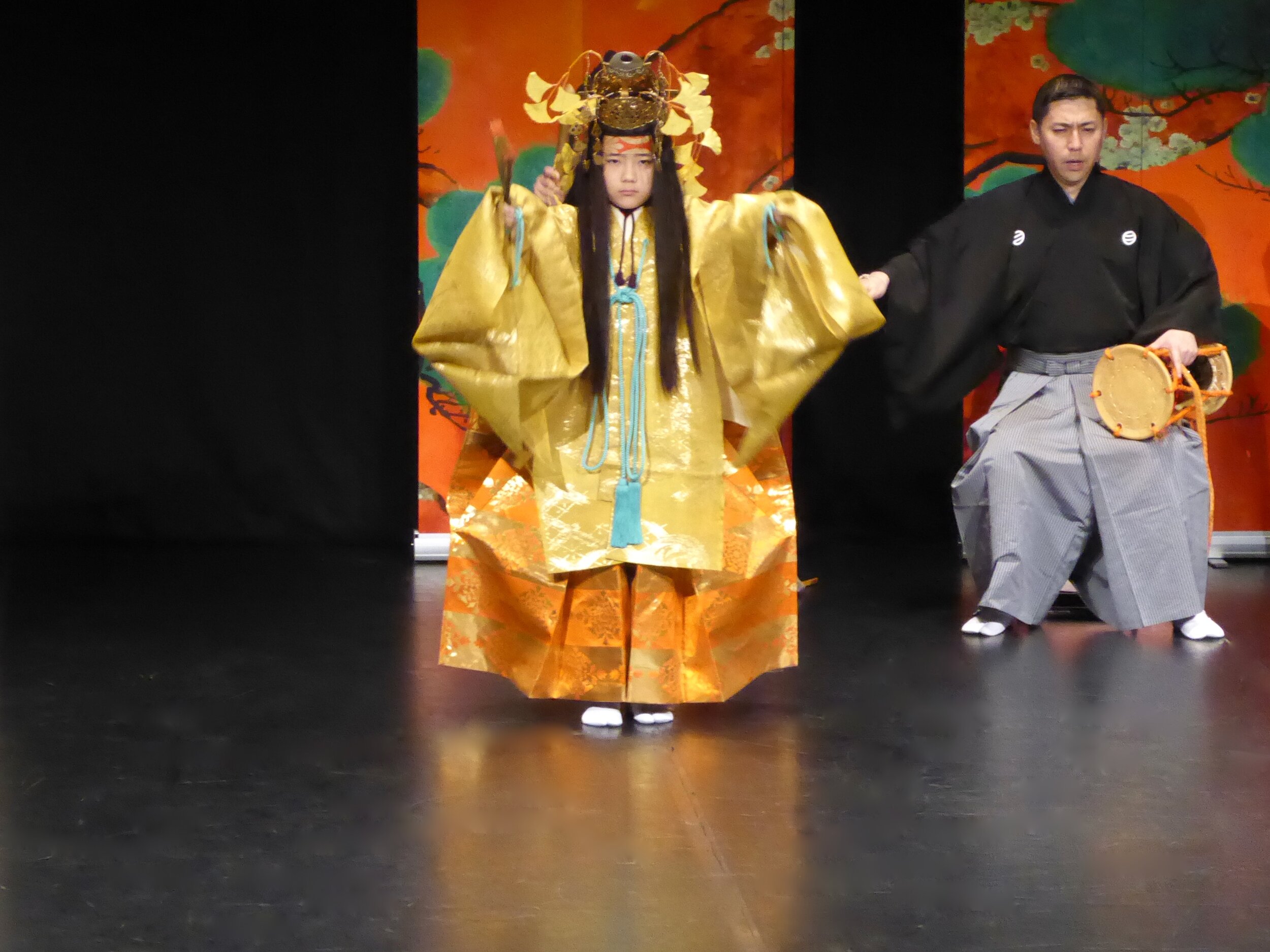
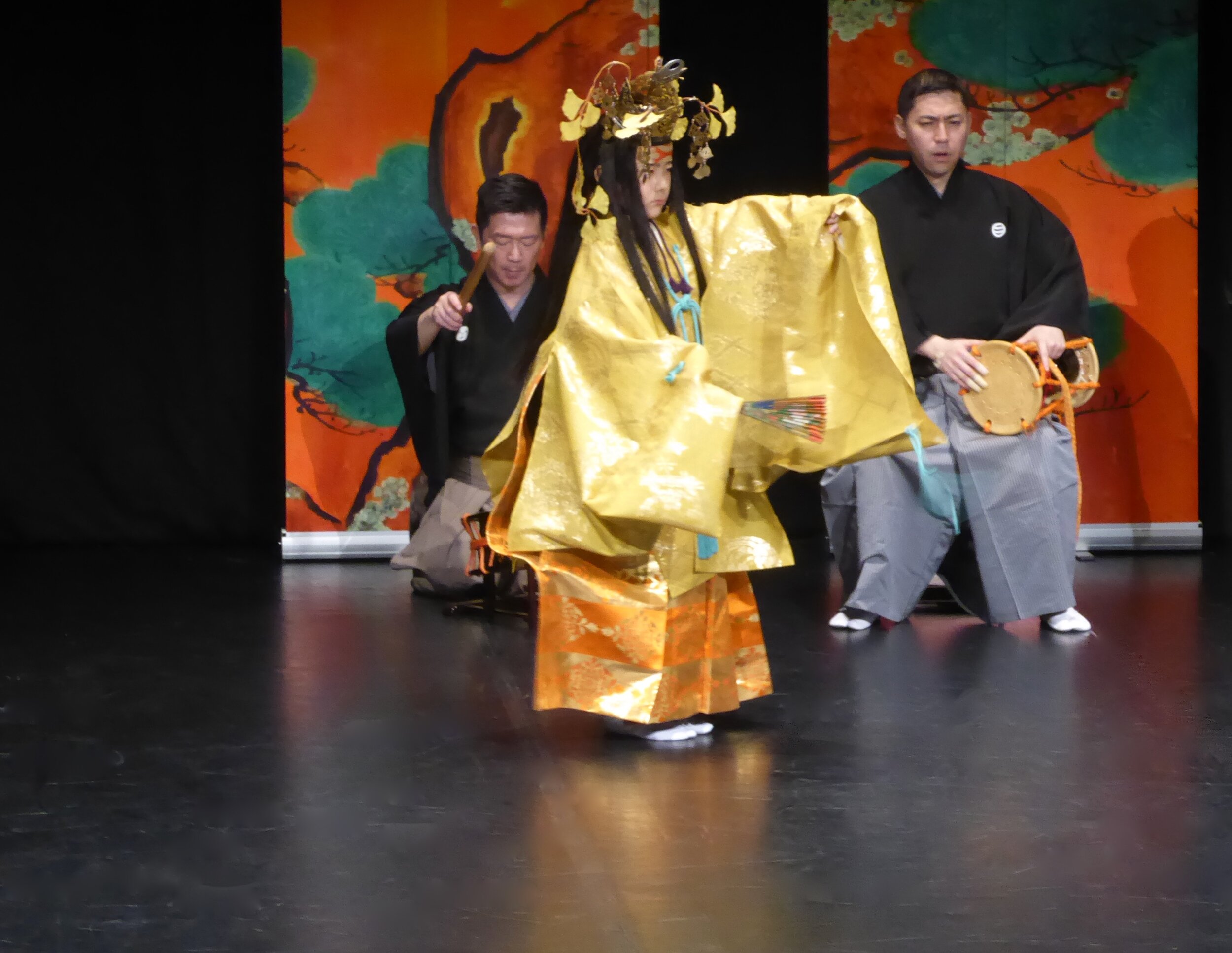
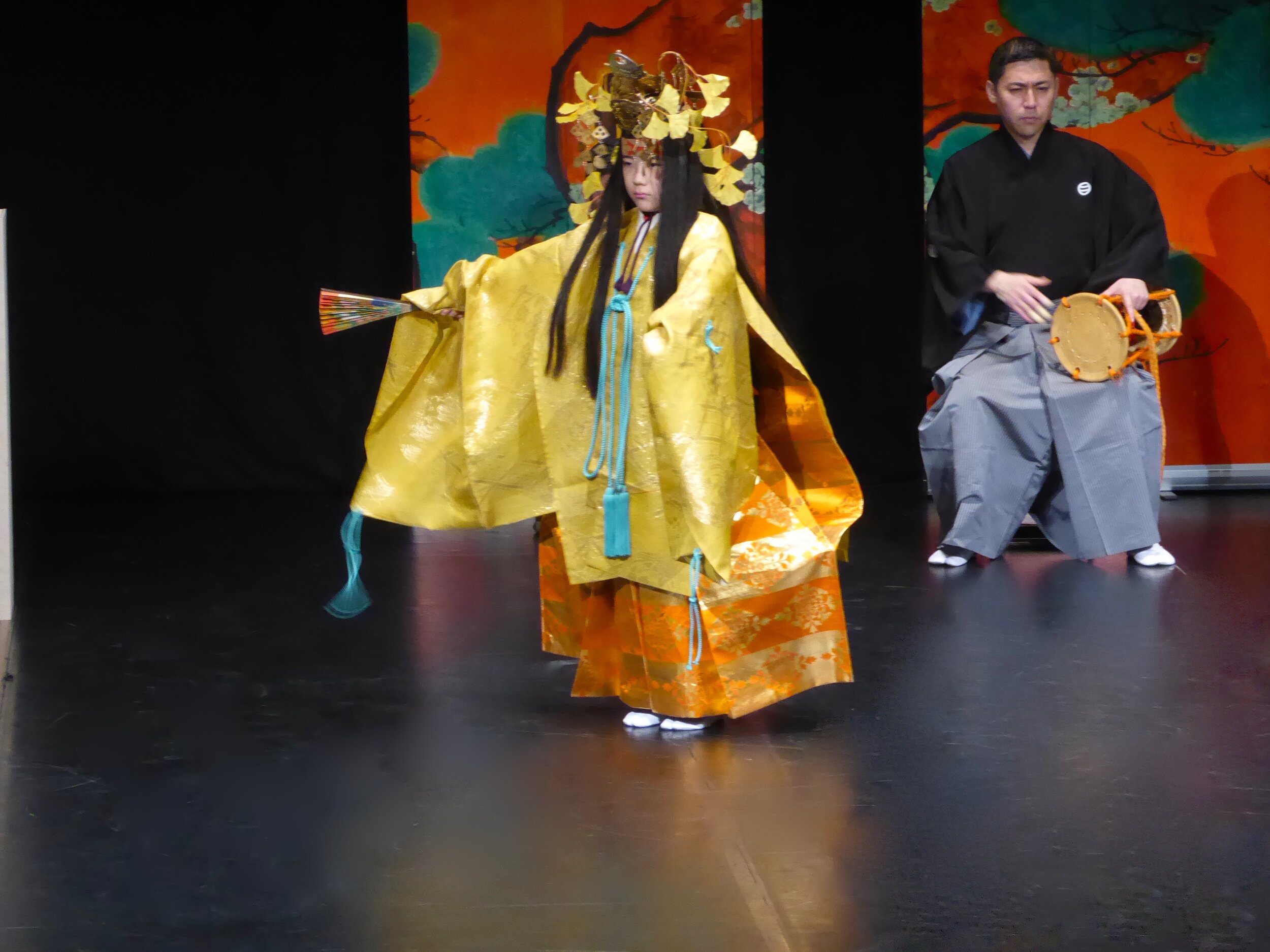

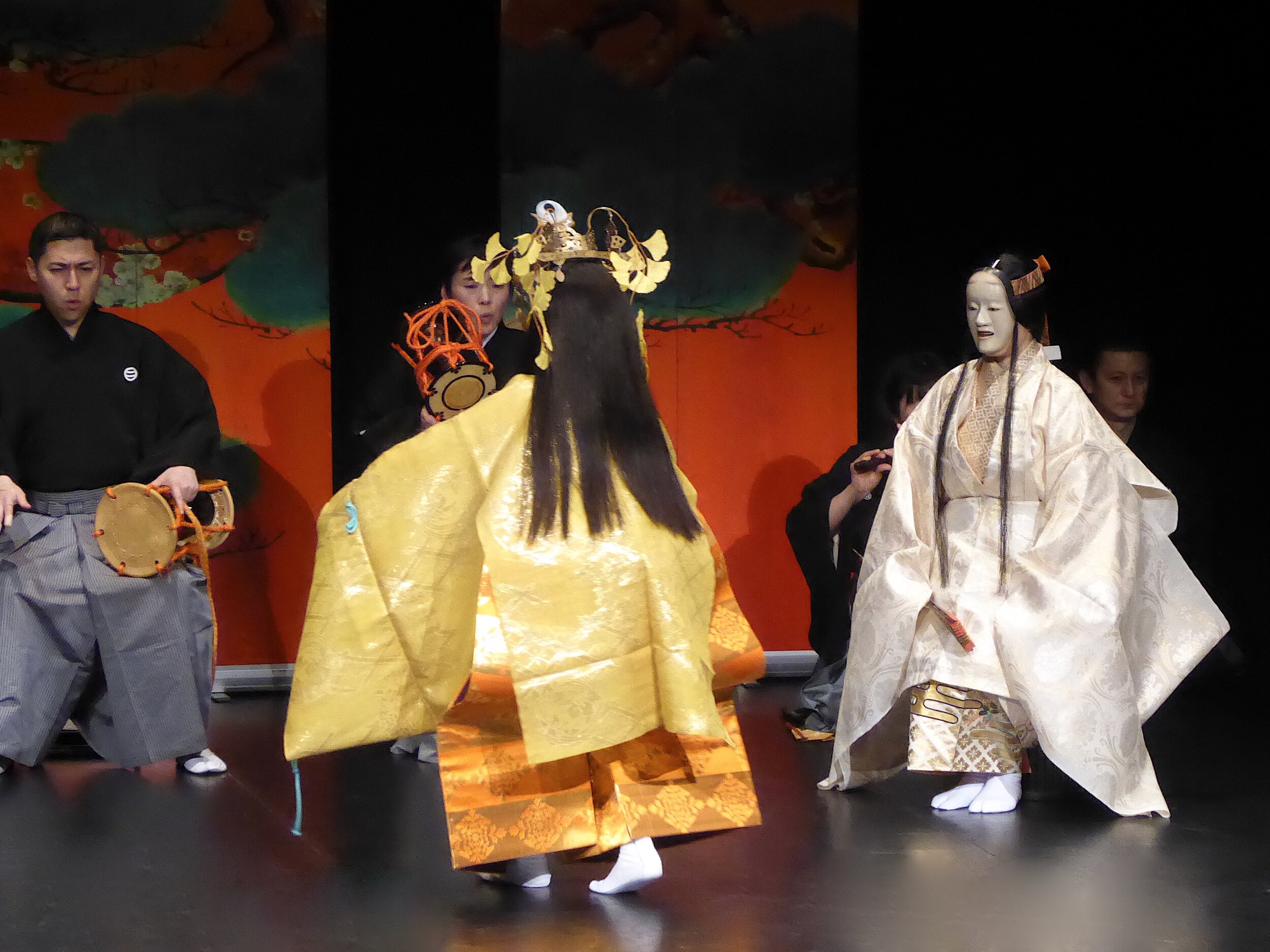
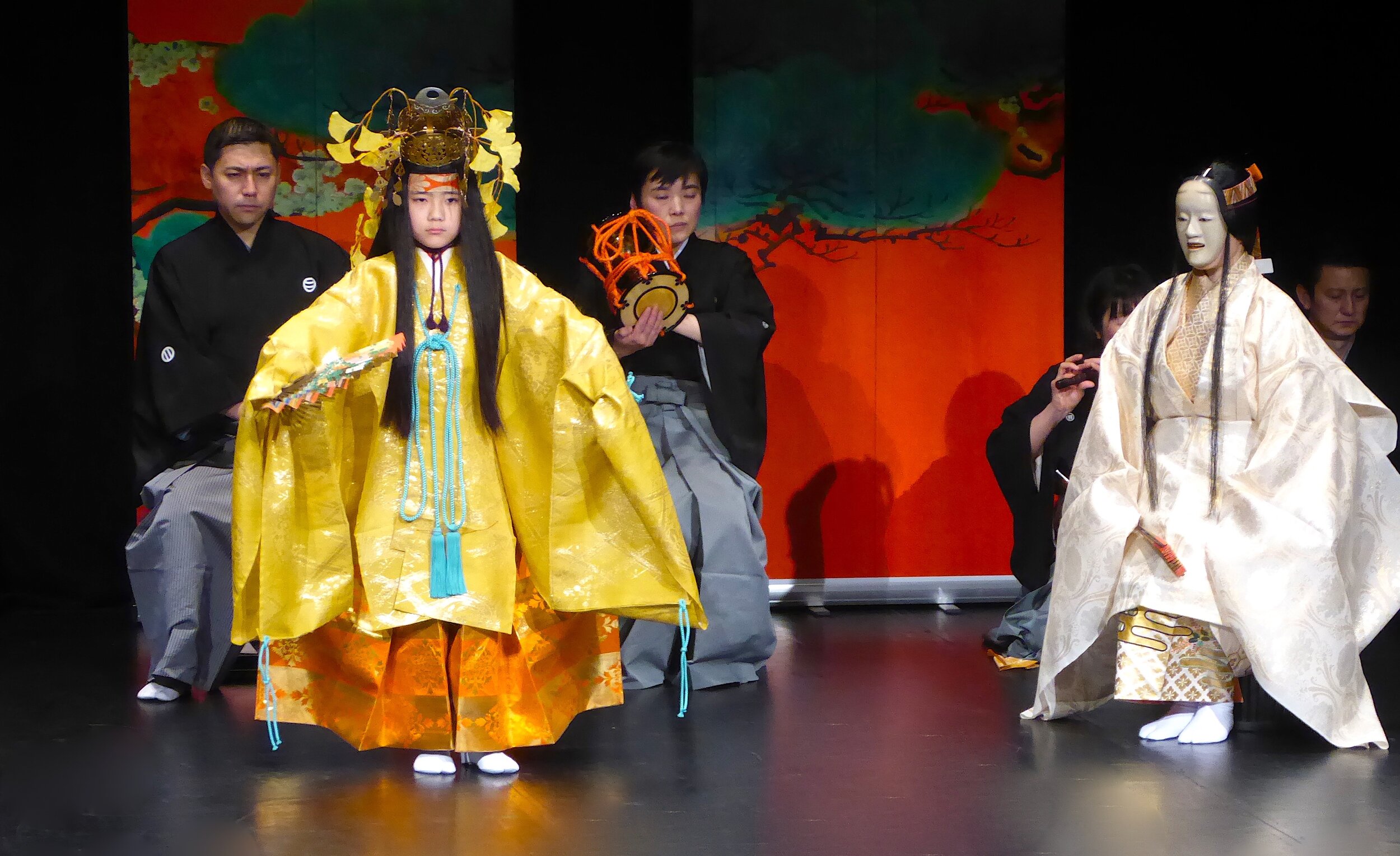
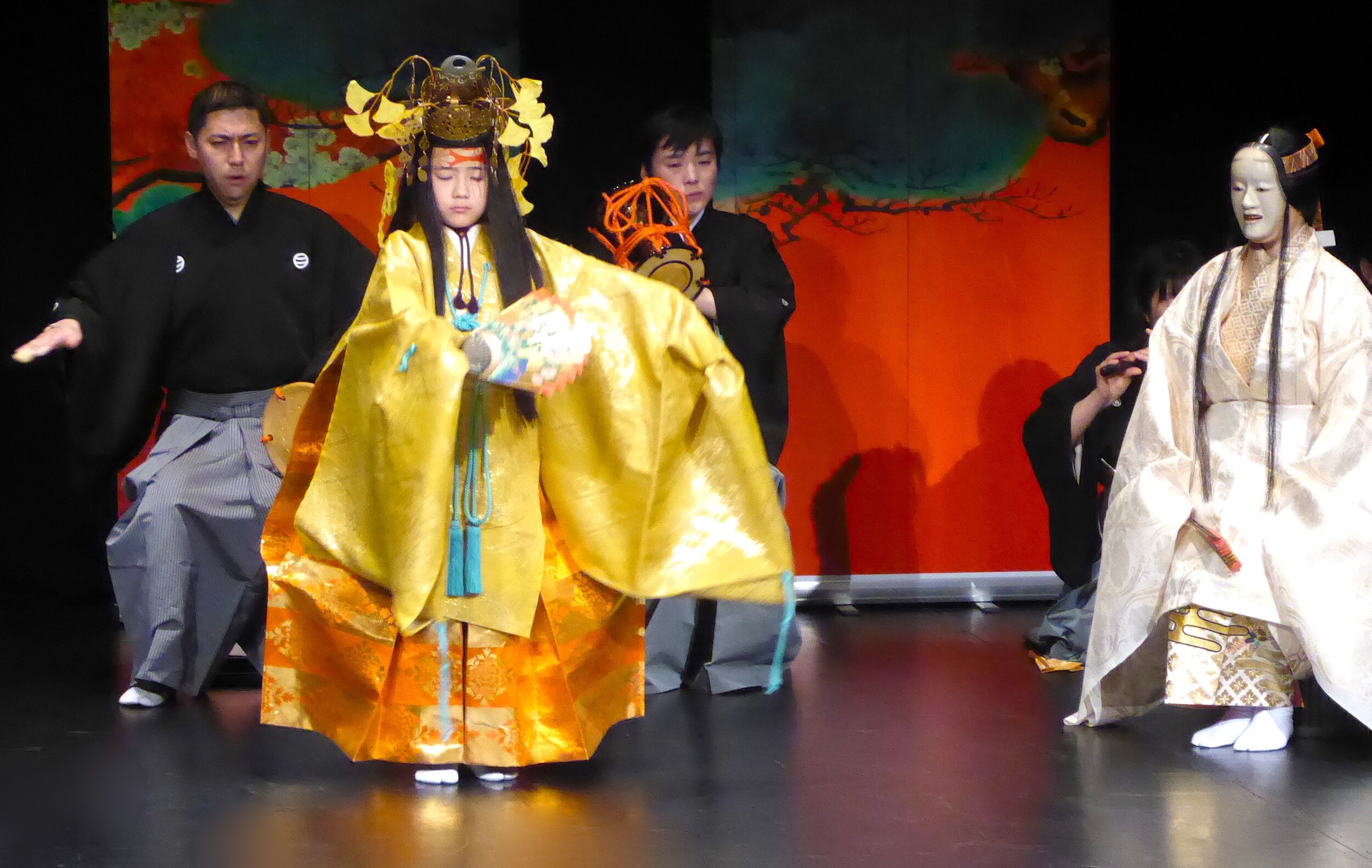
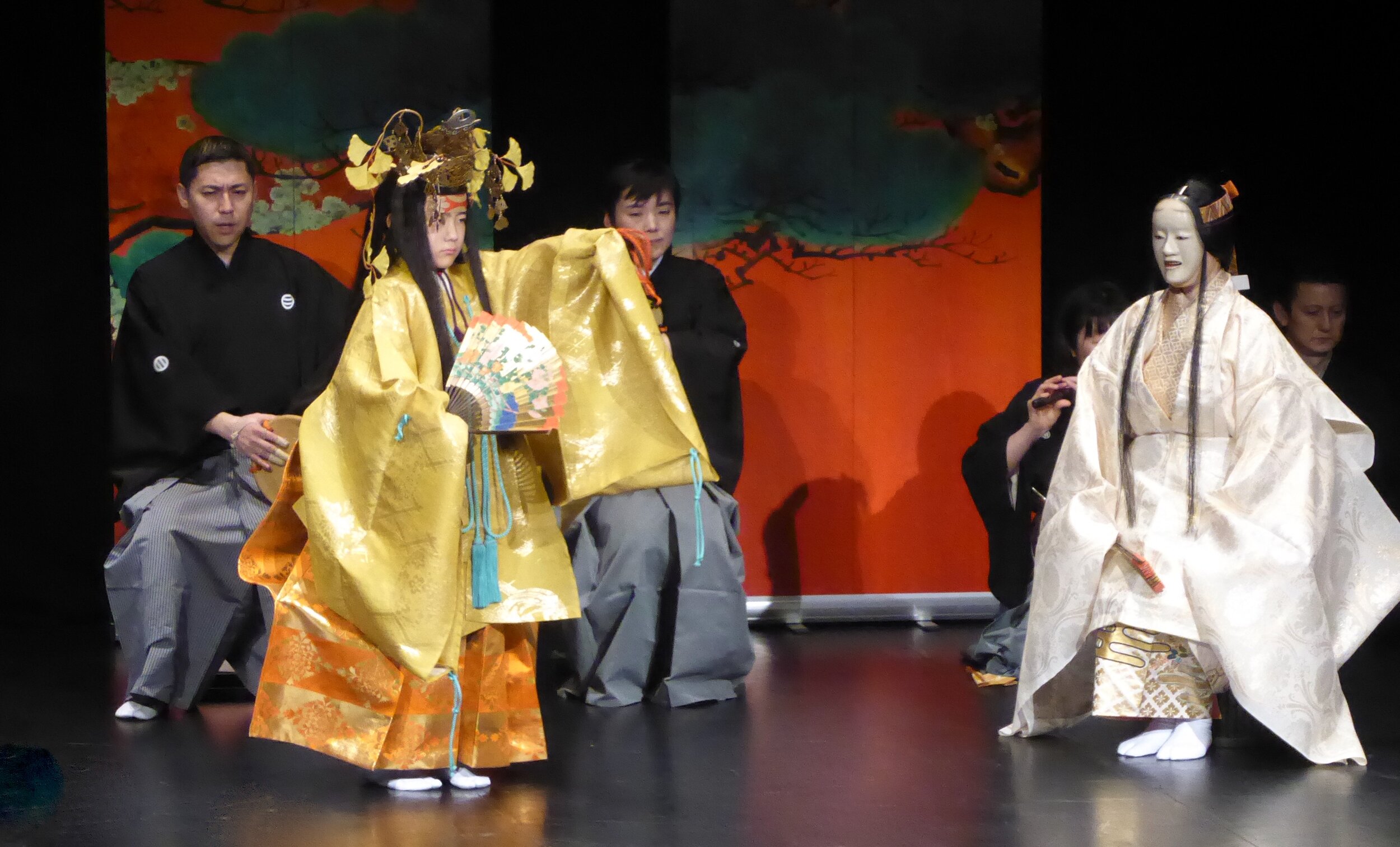
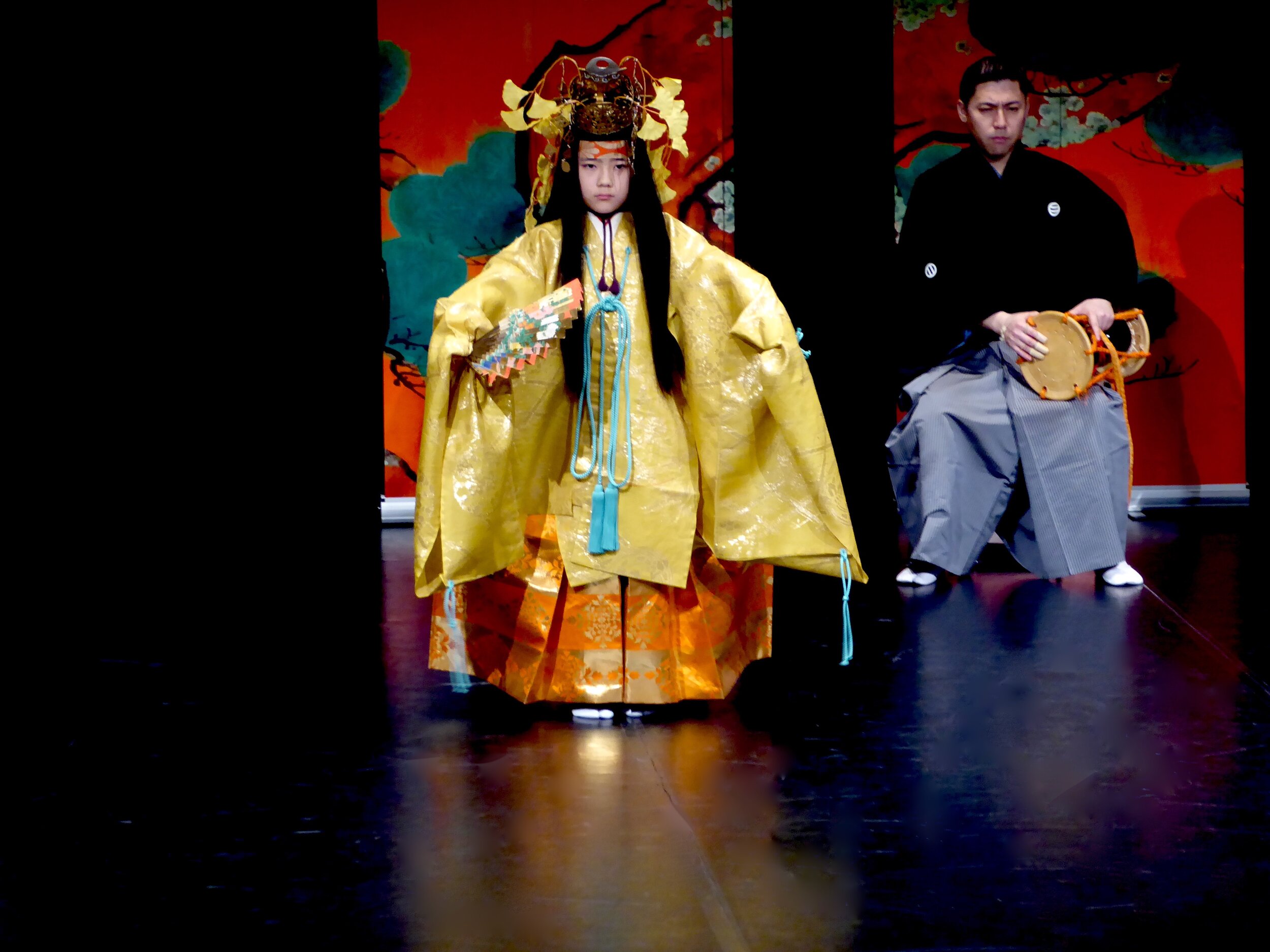
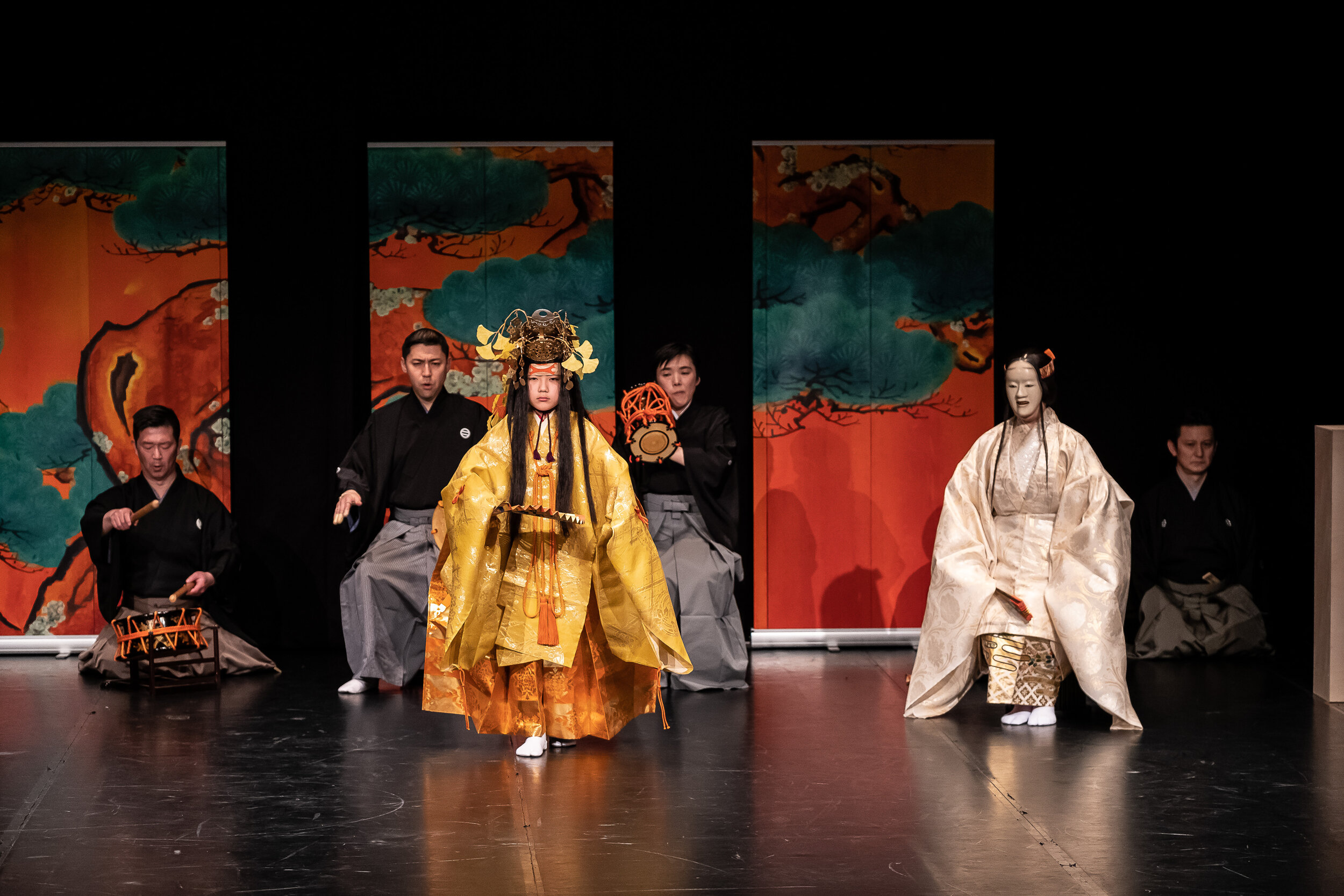
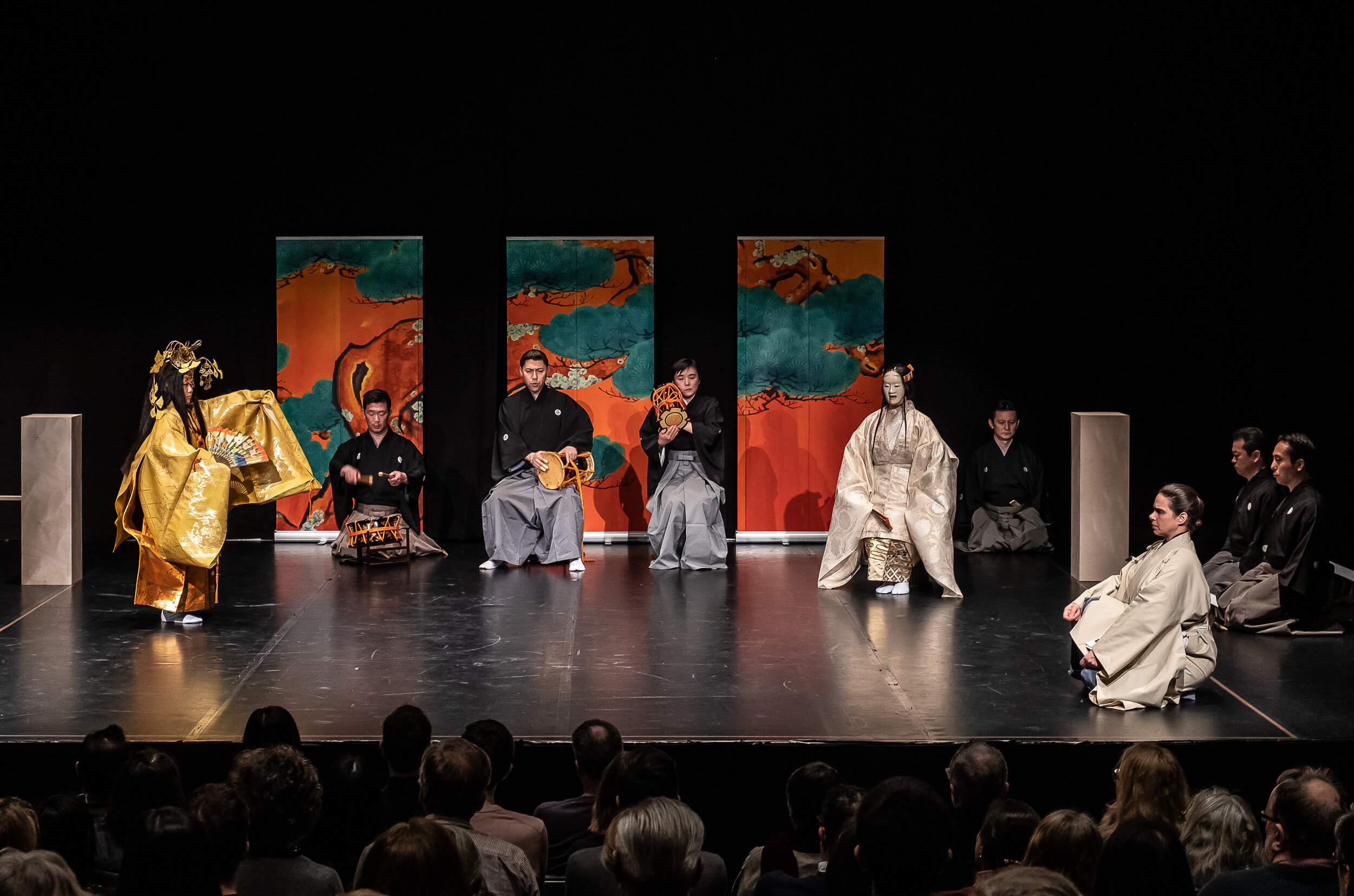
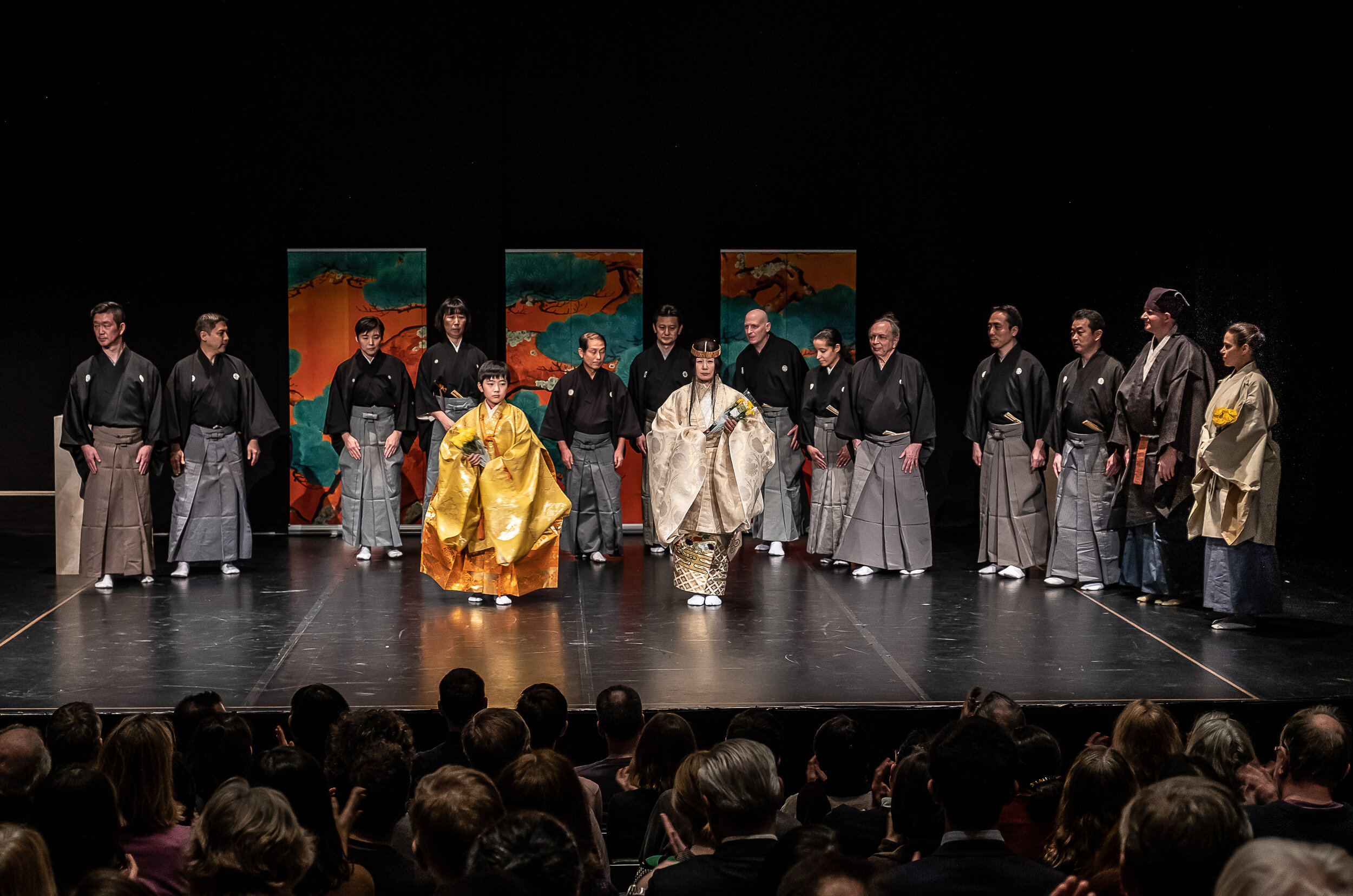
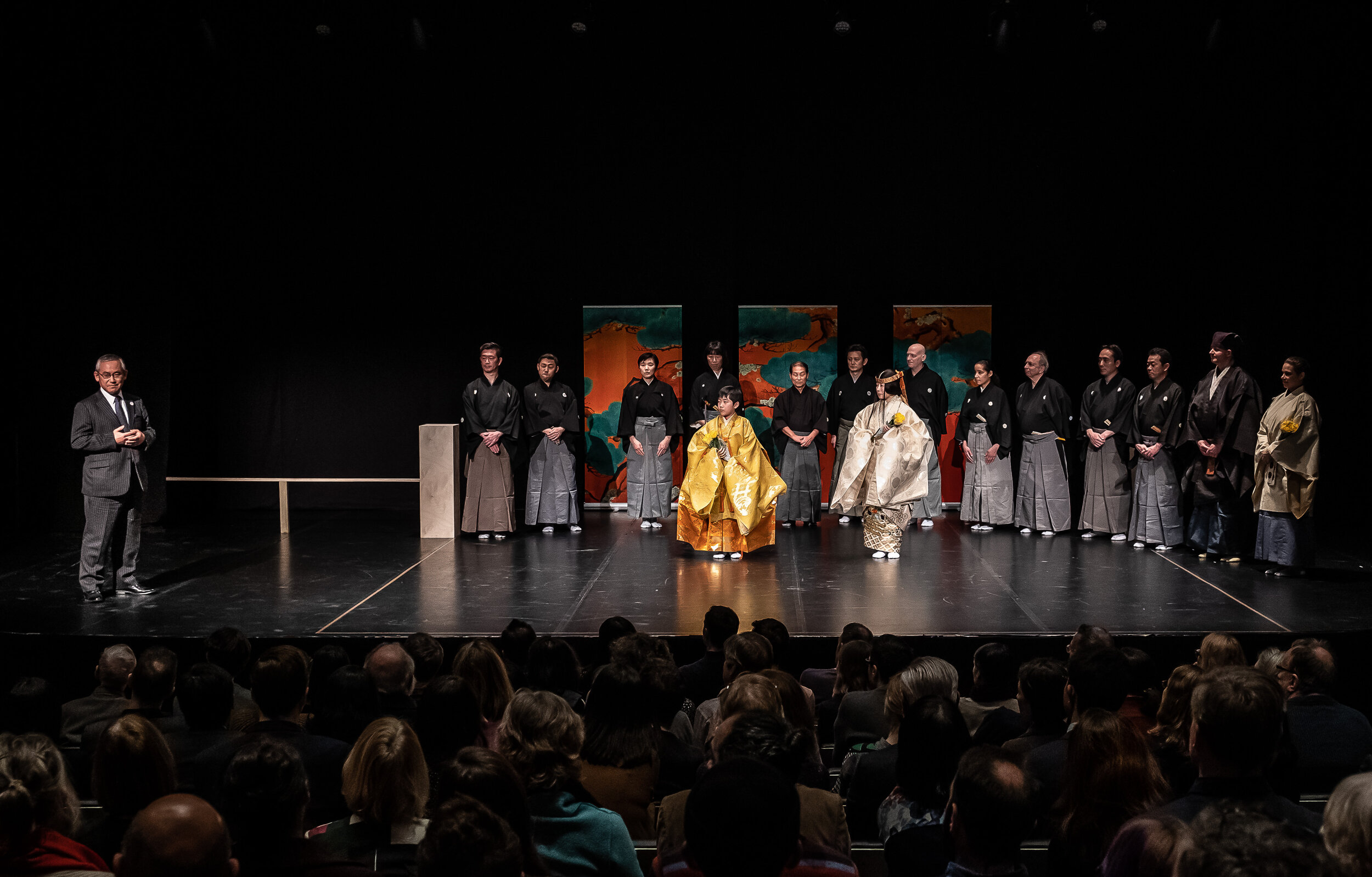
Above: Photographs from the opening night of the classical noh Takasago (performed as a han, or half noh) and the world premiere performance of Between the Stones at the Southbank Centre, London on 29 January 2020. Photographs by Clive Barda
Between the Stones text and original images©Jannette Cheong 2017. All rights reserved. Performance Photographs for Between the Stones by Clive Barda. Archive film footage by Jannette Cheong. Any unauthorised broadcasting, public performance, copying or re-recording will constitute an infringement of copyright.



